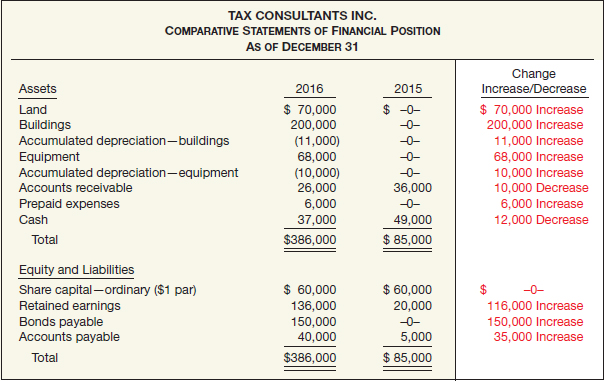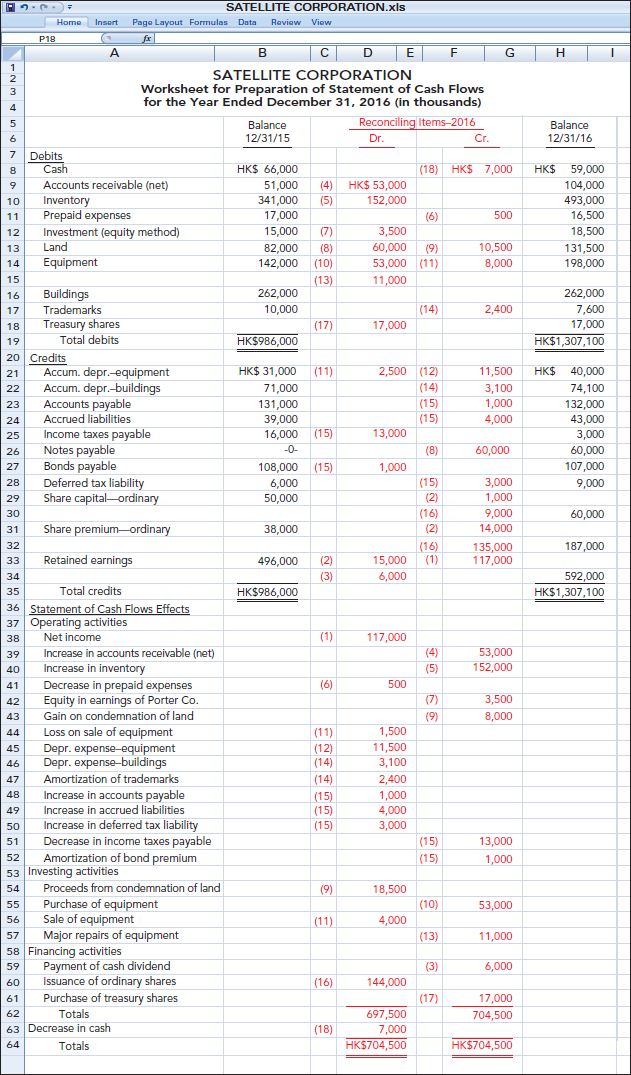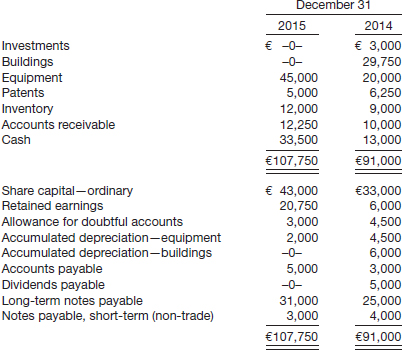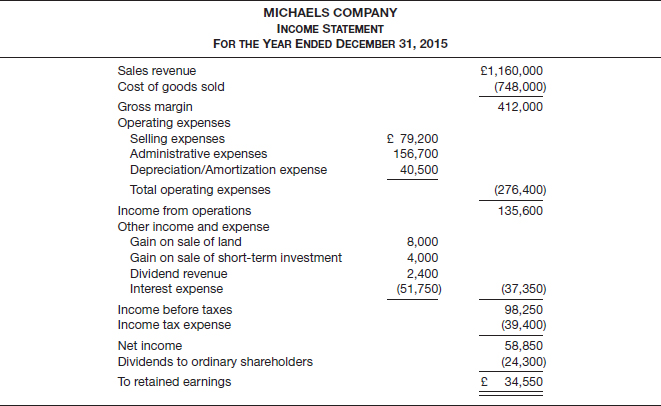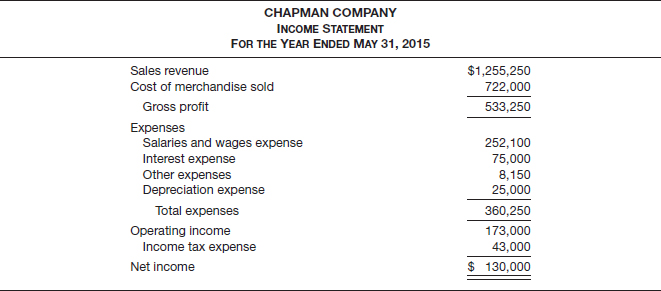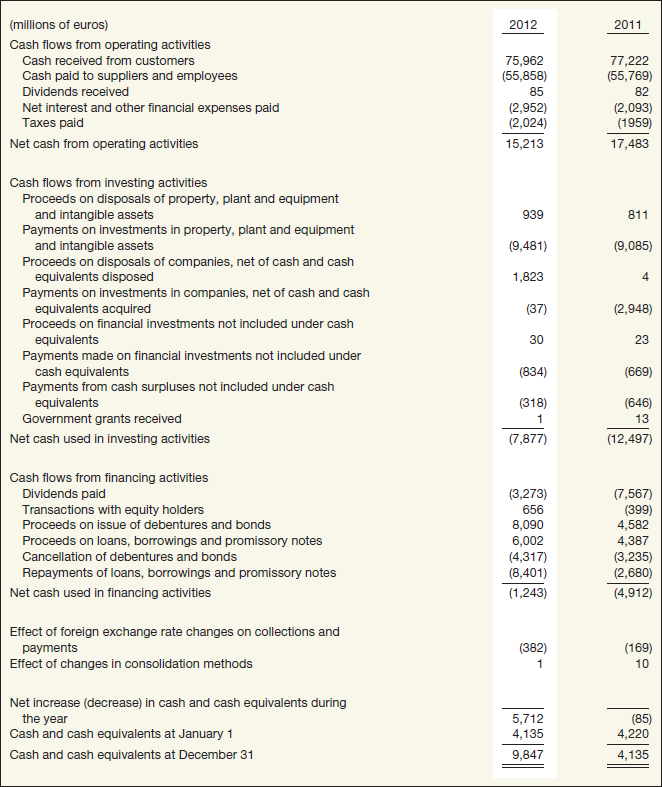LEARNING OBJECTIVES
After studying this chapter, you should be able to:
- 1 Describe the purpose of the statement of cash flows.
- 2 Identify the major classifications of cash flows.
- 3 Prepare a statement of cash flows.
- 4 Differentiate between net income and net cash flow from operating activities.
- 5 Determine net cash flows from investing and financing activities.
- 6 Identify sources of information for a statement of cash flows.
- 7 Contrast the direct and indirect methods of calculating net cash flow from operating activities.
- 8 Discuss special problems in preparing a statement of cash flows.
- 9 Explain the use of a worksheet in preparing a statement of cash flows.
Show Me the Money!
Investors usually look to net income as a key indicator of a company's financial health and future prospects. The following graph shows the net income of one company over a seven-year period.
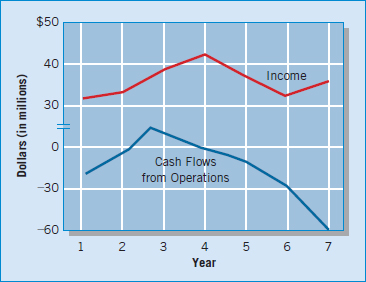
The company showed a pattern of consistent profitability and even some periods of income growth. Between years 1 and 4, net income for this company grew by 32 percent, from $31 million to $41 million. Would you expect its profitability to continue? The company had consistently paid dividends and interest. Would you expect it to continue to do so? Investors answered these questions by buying the company's shares. Eighteen months later, this company—W. T. Grant (USA)—filed for bankruptcy, in what was then the largest bankruptcy filing in the United States.
How could this happen? As indicated by the bottom line in the graph, the company had experienced several years of negative cash flows from its operations even though it reported profits. How can a company have negative cash flows while reporting profits? The answer lays partly in the fact that W. T. Grant was having trouble collecting the receivables from its credit sales, causing cash flow to be less than net income. Investors who analyzed the cash flows would have been likely to find an early warning signal of W. T. Grant's operating problems.
Investors can also look to cash flow information to sniff out companies that can be good buys. As one analyst stated when it comes to valuing shares: “Show me the money!” Here's the thinking behind that statement. Start with the “cash flows from operations” reported in the statement of cash flows, which (as you will learn in this chapter) consists of net income with non-cash charges (like depreciation and deferred taxes) added back and cash-draining events (like an inventory pile-up) taken out. Now subtract capital expenditures and dividends. What you're left with is free cash flow (as discussed in Chapter 5).
Many analysts like companies trading at low multiples of their free cash flow—low, that is, in relation to rivals today or the same company in past years. Why? They know that reported earnings can be misleading. Case in point: Computer-game firm Activision Blizzard (USA) reported net income of $113 million in a recent year. But it did better than that. It took in an additional $300 million, mostly for subscriptions to online multiplayer games. It gets the cash now but records the revenue only over time, as the subscriptions run out. A couple of investment houses put these shares on their buy list on the strength of its cash flows. So watch cash flow—to get an indicator of companies headed for trouble, as well as companies that may be undervalued.
Sources: Adapted from James A. Largay III and Clyde P. Stickney, “Cash Flows, Ratio Analysis, and the W. T. Grant Company Bankruptcy,” Financial Analysts Journal (July–August 1980), p. 51; and D. Fisher, “Cash Doesn't Lie,” Forbes (April 12, 2010), pp. 52–55.
PREVIEW OF CHAPTER 23
As the opening story indicates, examination of W. T. Grant's cash flows from operations would have shown the financial inflexibility that eventually caused the company's bankruptcy. This chapter explains the main components of a statement of cash flows and the types of information it provides. The content and organization of the chapter are as follows.
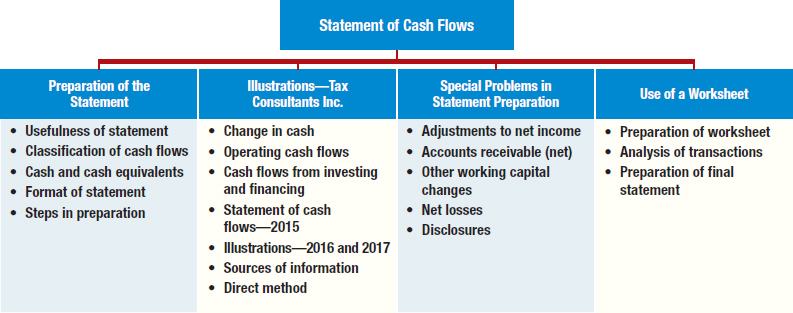
PREPARATION OF THE STATEMENT OF CASH FLOWS
LEARNING OBJECTIVE ![]()
Describe the purpose of the statement of cash flows.
The primary purpose of the statement of cash flows is to provide information about a company's cash receipts and cash payments during a period. A secondary objective is to provide cash-basis information about the company's operating, investing, and financing activities. [1] The statement of cash flows therefore reports cash receipts, cash payments, and net change in cash resulting from a company's operating, investing, and financing activities during a period. Its format reconciles the beginning and ending cash balances for the period.
![]() See the Authoritative Literature section (page 1223).
See the Authoritative Literature section (page 1223).
Usefulness of the Statement of Cash Flows
The statement of cash flows provides information to help investors, creditors, and others assess the following:
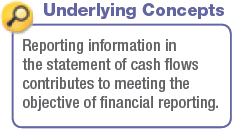
- 1. The entity's ability to generate future cash flows. A primary objective of financial reporting is to provide information with which to predict the amounts, timing, and uncertainty of future cash flows. By examining relationships between items such as sales and net cash flow from operating activities, or net cash flow from operating activities and increases or decreases in cash, it is possible to better predict the future cash flows than is possible using accrual-basis data alone.
- 2. The entity's ability to pay dividends and meet obligations. Simply put, cash is essential. Without adequate cash, a company cannot pay employees, settle debts, pay out dividends, or acquire equipment. A statement of cash flows indicates where the company's cash comes from and how the company uses its cash. Employees, creditors, shareholders, and customers should be particularly interested in this statement because it alone shows the flows of cash in a business.
- 3. The reasons for the difference between net income and net cash flow from operating activities. The net income number is important: It provides information on the performance of a company from one period to another. But some people are critical of accrual-basis net income because companies must make estimates to arrive at it. Such is not the case with cash. Thus, as the opening story showed, financial statement readers can benefit from knowing why a company's net income and net cash flow from operating activities differ and can assess for themselves the reliability of the income number.
- 4. The cash and non-cash investing and financing transactions during the period. Besides operating activities, companies undertake investing and financing transactions. Investing activities include the purchase and sale of assets other than a company's products or services. Financing activities include borrowings and repayments of borrowings, investments by owners, and distributions to owners. By examining a company's investing and financing activities, a financial statement reader can better understand why assets and liabilities increased or decreased during the period. For example, by reading the statement of cash flows, the reader might find answers to following questions:
- Why did cash decrease for Aixtron Aktiengesellschaft (DEU) when it reported net income for the year?
- How much did Telefónica, S.A. (ESP) spend on property, plant, and equipment, and intangible assets last year?
- Did dividends paid by BP plc (GBR) increase last year?
- How much money did Coca-Cola (USA) borrow last year?
- How much cash did Delhaize Group (BEL) use to repurchase ordinary shares?
Classification of Cash Flows
![]() LEARNING OBJECTIVE
LEARNING OBJECTIVE
Identify the major classifications of cash flows.
The statement of cash flows classifies cash receipts and cash payments by operating, investing, and financing activities. Transactions and other events characteristic of each kind of activity are as follows. [2]
- 1. Operating activities involve the cash effects of transactions that enter into the determination of net income, such as cash receipts from sales of goods and services, and cash payments to suppliers and employees for acquisitions of inventory and expenses. The amount of cash flows arising from operating activities is a key indicator of the extent to which the operations of the entity have generated sufficient cash flows to repay loans, maintain the operating capability of the entity, pay dividends, and make new investments without recourse to external sources of financing.
- 2. Investing activities generally involve non-current assets and include (a) making and collecting loans, and (b) acquiring and disposing of investments and productive long-lived assets. The separate disclosure of cash flows arising from investing activities is important because the cash flows represent the extent to which expenditures have been made for resources intended to generate future income and cash flows.
- 3. Financing activities involve liability and equity items and include (a) obtaining cash from creditors and repaying the amounts borrowed, and (b) obtaining capital from owners and providing them with a return on, and a return of, their investment. The separate disclosure of cash flows arising from financing activities is important because it is useful in predicting claims on future cash flows by providers of capital to a company.
Illustration 23-1 (page 1184) classifies the typical cash receipts and payments of a company according to operating, investing, and financing activities. The operating activities category is the most important. It shows the cash provided by company operations. This source of cash is generally considered to be the best measure of a company's ability to generate enough cash to continue as a going concern.
Note the following general guidelines about the classification of cash flows.
- 1. Operating activities involve income statement items.
- 2. Investing activities involve cash flows resulting from changes in investments and other non-current asset items.
- 3. Financing activities involve cash flows resulting from changes in equity and non-current liability items.
IFRS allows some flexibility regarding the classification of certain items. Interest and dividends paid can be classified as either operating or financing, depending on what treatment the company thinks is most appropriate. Similarly, interest and dividends received can be classified as either operating or investing. Taxes paid are classified as operating except in circumstances where they can be identified with specific investing or financing activities. In order to limit the complexity of our presentation and to avoid ambiguity in assignment material, in Illustration 23-1 we have identified specific treatment for each of these items rather than allowing choices. All assignment material is based on this treatment.1
ILLUSTRATION 23-1
Classification of Typical Cash Inflows and Outflows
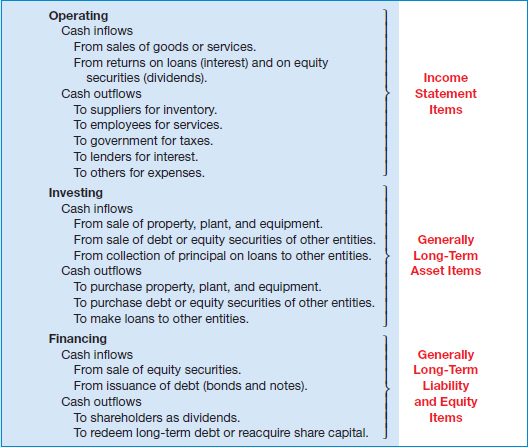
Also, companies classify some cash flows relating to operating activities as investing or financing activities. For example, a company classifies the total cash received from the sale of property, plant, and equipment as an investing activity. Therefore, sales of those assets are not considered operating activities. Because of this (as is discussed more fully later in the chapter), companies must eliminate any gains or losses arising from the disposal of these assets to arrive at net cash flow from operating activities. Likewise, the payment to extinguish debt is a financing cash flow and should be classified as such. Any gain or loss related to the extinguishment is eliminated from net cash provided by operating activities.
Cash and Cash Equivalents
The basis recommended by the IASB for the statement of cash flows is actually “cash and cash equivalents.” Cash equivalents are short-term, highly liquid investments that are both:
- Readily convertible to known amounts of cash, and
- So near their maturity that they present insignificant risk of changes in value (e.g., due to changes in interest rates).
Generally, only investments with original maturities of three months or less qualify under this definition. Examples of cash equivalents are Treasury bills, commercial paper, and money market funds purchased with cash that is in excess of immediate needs. Equity investments are excluded from cash equivalents unless they are, in substance, cash equivalents. Although we use the term “cash” throughout our discussion and illustrations, we mean cash and cash equivalents when reporting the cash flows and the net increase or decrease in cash. [3]
What do the numbers mean? HOW'S MY CASH FLOW?
To evaluate overall cash flows, it is useful to understand where in the product life cycle a company is. Generally, companies move through several stages of development, which have implications for cash flows. As the graph below shows, the pattern of cash flows from operating, financing, and investing activities will vary depending on the stage of the product life cycle.
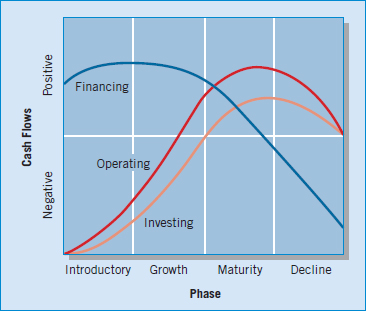
In the introductory phase, the product is likely not generating much revenue (net operating cash flow is negative). Because the company is making heavy investments to get a product off the ground, cash flow from investment is negative, and financing cash flows are positive.
As the product moves to the growth and maturity phases, these cash flow relationships reverse. The product generates more cash flows from operations, which can be used to cover investments needed to support the product, and less cash is needed from financing. So are negative operating cash flows bad? Not always. It depends on the product life cycle.
Source: Adapted from Paul D. Kimmel, Jerry J. Weygandt, and Donald E. Kieso, Financial Accounting: Tools for Business Decision Making, 7th ed. (New York: John Wiley & Sons, 2013), p. 631.
Format of the Statement of Cash Flows
The three activities we discussed above constitute the general format of the statement of cash flows. The operating activities section always appears first. It is followed by the investing activities section and then the financing activities section.
A company reports the individual inflows and outflows from investing and financing activities separately. That is, a company reports them gross, not netted against one another. Thus, a cash outflow from the purchase of property is reported separately from the cash inflow from the sale of property. Similarly, a cash inflow from the issuance of debt is reported separately from the cash outflow from its retirement.
The net increase or decrease in cash reported during the period should reconcile the beginning and ending cash balances as reported in the comparative statements of financial position. The general format of the statement of cash flows presents the results of the three activities discussed previously—operating, investing, and financing. Illustration 23-2 shows a widely used form of the statement of cash flows.
ILLUSTRATION 23-2
Format of the Statement of Cash Flows

Steps in Preparation
Companies prepare the statement of cash flows differently from the three other basic financial statements. For one thing, it is not prepared from an adjusted trial balance. The cash flow statement requires detailed information concerning the changes in account balances that occurred between two points in time. An adjusted trial balance will not provide the necessary data. Second, the statement of cash flows deals with cash receipts and payments. As a result, the company must adjust the effects of the use of accrual accounting to determine cash flows. The information to prepare this statement usually comes from three sources:
- 1. Comparative statements of financial position provide the amount of the changes in assets, liabilities, and equities from the beginning to the end of the period.
- 2. Current income statement data help determine the amount of net cash provided by or used by operations during the period.
- 3. Selected transaction data from the general ledger provide additional detailed information needed to determine how the company provided or used cash during the period.
Preparing the statement of cash flows from the data sources above involves three major steps:
Step 1. Determine the change in cash. This procedure is straightforward. A company can easily compute the difference between the beginning and the ending cash balance from examining its comparative statements of financial position.
Step 2. Determine the net cash flow from operating activities. This procedure is complex. It involves analyzing not only the current year's income statement but also comparative statements of financial position as well as selected transaction data.
Step 3. Determine net cash flows from investing and financing activities. A company must analyze all other changes in the statement of financial position accounts to determine their effects on cash.
On the following pages, we work through these three steps in the process of preparing the statement of cash flows for Tax Consultants Inc. over several years.
ILLUSTRATIONS—TAX CONSULTANTS INC.
![]() LEARNING OBJECTIVE
LEARNING OBJECTIVE
Prepare a statement of cash flows.
We show the steps in preparing the statement of cash flows using data for Tax Consultants Inc. To begin, we use the first year of operations for Tax Consultants Inc. The company started on January 1, 2015, when it issued 60,000 ordinary shares of $1 par value for $60,000 cash. The company rented its office space, furniture, and equipment, and performed tax consulting services throughout the first year. The comparative statements of financial position at the beginning and end of the year 2015 appear in Illustration 23-3.
ILLUSTRATION 23-3
Comparative Statements of Financial Position, Tax Consultants Inc., Year 1

Illustration 23-4 shows the income statement and additional information for Tax Consultants.
ILLUSTRATION 23-4
Income Statement, Tax Consultants Inc., Year 1
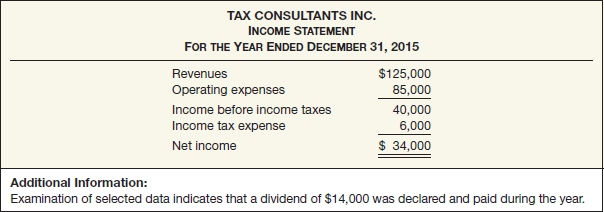
Step 1: Determine the Change in Cash
To prepare a statement of cash flows, the first step is to determine the change in cash. This is a simple computation. Tax Consultants had no cash on hand at the beginning of the year 2015. It had $49,000 on hand at the end of 2015. Thus, cash changed (increased) in 2015 by $49,000.
Step 2: Determine Net Cash Flow from Operating Activities
LEARNING OBJECTIVE ![]()
Differentiate between net income and net cash flow from operating activities.
To determine net cash flow from operating activities,2 companies adjust net income in numerous ways. A useful starting point is to understand why net income must be converted to net cash provided by operating activities.
Under IFRS, most companies use the accrual basis of accounting. As you have learned, this basis requires that companies record revenue when they satisfy performance obligations and record expenses when incurred. Revenues may include credit sales for which the company has not yet collected cash. Expenses incurred may include some items that the company has not yet paid in cash. Thus, under the accrual basis of accounting, net income is not the same as net cash flow from operating activities.
To arrive at net cash flow from operating activities, a company must determine revenues and expenses on a cash basis. It does this by eliminating the effects of income statement transactions that do not result in an increase or decrease in cash. Illustration 23-5 shows the relationship between net income and net cash flow from operating activities.
ILLUSTRATION 23-5
Net Income versus Net Cash Flow from Operating Activities
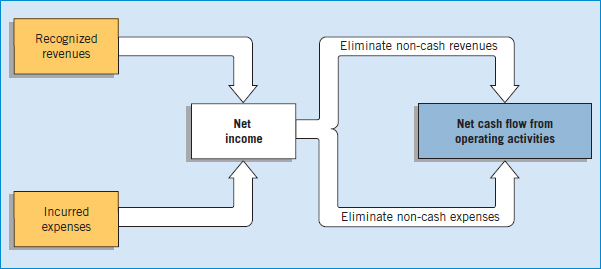
In this chapter, we use the term net income to refer to accrual-based net income. A company may convert net income to net cash flow from operating activities through either a direct method or an indirect method. Due to its widespread use in practice, in the following sections we illustrate use of the indirect method. Later in the chapter, we describe the direct method and discuss the advantages and disadvantages of the two methods.
The indirect method (or reconciliation method) starts with net income and converts it to net cash flow from operating activities. In other words, the indirect method adjusts net income for items that affected reported net income but did not affect cash. To compute net cash flow from operating activities, a company adds back non-cash charges in the income statement to net income and deducts non-cash credits. We explain the two adjustments to net income for Tax Consultants, namely, the increases in accounts receivable and accounts payable, as follows.
Increase in Accounts Receivable–Indirect Method
Tax Consultants' accounts receivable increased by $36,000 (from $0 to $36,000) during the year. For Tax Consultants, this means that cash receipts were $36,000 lower than revenues. The Accounts Receivable account in Illustration 23-6 shows that Tax Consultants had $125,000 in revenues (as reported on the income statement), but it collected only $89,000 in cash.
ILLUSTRATION 23-6
Analysis of Accounts Receivable

As shown in Illustration 23-7, to adjust net income to net cash provided by operating activities, Tax Consultants must deduct the increase of $36,000 in accounts receivable from net income. When the Accounts Receivable balance decreases, cash receipts are higher than revenue recognized under the accrual basis. Therefore, the company adds to net income the amount of the decrease in accounts receivable to arrive at net cash provided by operating activities.
Increase in Accounts Payable–Indirect Method
When accounts payable increase during the year, expenses on an accrual basis exceed those on a cash basis. Why? Because Tax Consultants incurred expenses, but some of the expenses are not yet paid. To convert net income to net cash flow from operating activities, Tax Consultants must add back the increase of $5,000 in accounts payable to net income.
As a result of the accounts receivable and accounts payable adjustments, Tax Consultants determines net cash provided by operating activities is $3,000 for the year 2015. Illustration 23-7 shows this computation.
ILLUSTRATION 23-7
Computation of Net Cash Flow from Operating Activities, Year 1—Indirect Method

Step 3: Determine Net Cash Flows from Investing and Financing Activities
![]() LEARNING OBJECTIVE
LEARNING OBJECTIVE
Determine net cash flows from investing and financing activities.
After Tax Consultants has computed the net cash provided by operating activities, the next step is to determine whether any other changes in the statement of financial position accounts caused an increase or decrease in cash.
For example, an examination of the remaining statement of financial position accounts for Tax Consultants shows increases in both ordinary shares and retained earnings. The Share Capital—Ordinary increase of $60,000 resulted from the issuance of ordinary shares for cash. The issuance of ordinary shares is reported in the statement of cash flows as a receipt of cash from a financing activity.
Two items caused the retained earnings increase of $20,000:
- 1. Net income of $34,000 increased retained earnings.
- 2. Declaration of $14,000 of dividends decreased retained earnings.
Tax Consultants has converted net income into net cash flow from operating activities, as explained earlier. The additional data indicate that it paid the dividend. Thus, the company reports the dividend payment as a cash outflow, classified as a financing activity.
Statement of Cash Flows–2015
We are now ready to prepare the statement of cash flows. The statement starts with the operating activities section. Tax Consultants may use either the direct or indirect method to report net cash flow from operating activities.
The IASB encourages the use of the direct method over the indirect method. [4] If a company uses the indirect method, it can either report the reconciliation within the statement of cash flows or can provide it in a separate schedule, with the statement of cash flows reporting only the net cash flow from operating activities. Throughout this chapter, we use the indirect method, which is also used more extensively in practice.3
Illustration 23-8 shows the statement of cash flows for Tax Consultants Inc., for year 1 (2015).
ILLUSTRATION 23-8
Statement of Cash Flows, Tax Consultants Inc., Year 1

As indicated, the $60,000 increase in ordinary shares results in a financing-activity cash inflow. The payment of $14,000 in cash dividends is a financing-activity outflow of cash. The $49,000 increase in cash reported in the statement of cash flows agrees with the increase of $49,000 shown in the comparative statements of financial position (in Illustration 23-3 on page 1187) as the change in the Cash account.
Illustration–2016
Tax Consultants Inc. continued to grow and prosper in its second year of operations. The company purchased land, building, and equipment, and revenues and net income increased substantially over the first year. Illustrations 23-9 and 23-10 (on page 1191) present information related to the second year of operations for Tax Consultants Inc.
ILLUSTRATION 23-9
Comparative Statements of Financial Position, Tax Consultants Inc., Year 2
ILLUSTRATION 23-10
Income Statement, Tax Consultants Inc., Year 2
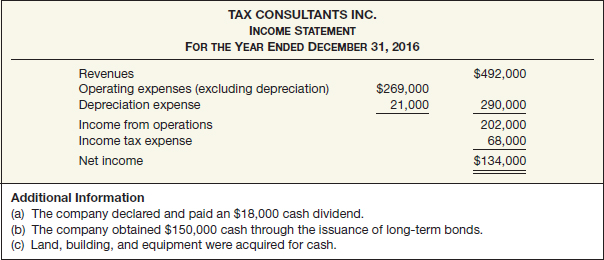
Step 1: Determine the Change in Cash
To prepare a statement of cash flows from the available information, the first step is to determine the change in cash. As indicated from the information presented, cash decreased $12,000 ($49,000−$37,000).
Step 2: Determine Net Cash Flow from Operating Activities–Indirect Method
Using the indirect method, we adjust net income of $134,000 on an accrual basis to arrive at net cash flow from operating activities. Explanations for the adjustments to net income follow.
Decrease in Accounts Receivable. Accounts receivable decreased during the period because cash receipts (cash-basis revenues) are higher than revenues reported on an accrual basis. To convert net income to net cash flow from operating activities, the decrease of $10,000 in accounts receivable must be added to net income.
Increase in Prepaid Expenses. When prepaid expenses (assets) increase during a period, expenses on an accrual-basis income statement are lower than they are on a cash-basis income statement. The reason: Tax Consultants has made cash payments in the current period, but expenses (as charges to the income statement) have been deferred to future periods. To convert net income to net cash flow from operating activities, the company must deduct from net income the increase of $6,000 in prepaid expenses. An increase in prepaid expenses results in a decrease in cash during the period.
Increase in Accounts Payable. Like the increase in 2015, Tax Consultants must add the 2016 increase of $35,000 in accounts payable to net income, to convert to net cash flow from operating activities. The company incurred a greater amount of expense than the amount of cash it disbursed.
Depreciation Expense (Increase in Accumulated Depreciation). The purchase of depreciable assets is a use of cash, shown in the investing section in the year of acquisition. Tax Consultants' depreciation expense of $21,000 (also represented by the increase in accumulated depreciation) is a non-cash charge; the company adds it back to net income, to arrive at net cash flow from operating activities. The $21,000 is the sum of the $11,000 depreciation on the building plus the $10,000 depreciation on the equipment.
Certain other periodic charges to expense do not require the use of cash. Examples are the amortization of intangible assets and depletion expense. Such charges are treated in the same manner as depreciation. Companies frequently list depreciation and similar non-cash charges as the first adjustments to net income in the statement of cash flows.
As a result of the foregoing items, net cash provided by operating activities is $194,000, as shown in Illustration 23-11.
ILLUSTRATION 23-11
Computation of Net Cash Flow from Operating Activities, Year 2—Indirect Method

Step 3: Determine Net Cash Flows from Investing and Financing Activities
After you have determined the items affecting net cash provided by operating activities, the next step involves analyzing the remaining changes in the statement of financial position accounts. Tax Consultants Inc. analyzed the following accounts.
Increase in Land. As indicated from the change in the Land account, the company purchased land of $70,000 during the period. This transaction is an investing activity, reported as a use of cash.
Increase in Buildings and Related Accumulated Depreciation. As indicated in the additional data, and from the change in the Buildings account, Tax Consultants acquired an office building using $200,000 cash. This transaction is a cash outflow, reported in the investing section. The $11,000 increase in accumulated depreciation results from recording depreciation expense on the building. As indicated earlier, the reported depreciation expense has no effect on the amount of cash.
Increase in Equipment and Related Accumulated Depreciation. An increase in equipment of $68,000 resulted because the company used cash to purchase equipment. This transaction is an outflow of cash from an investing activity. The depreciation expense entry for the period explains the increase in Accumulated Depreciation—Equipment.
Increase in Bonds Payable. The Bonds Payable account increased $150,000. Cash received from the issuance of these bonds represents an inflow of cash from a financing activity.
Increase in Retained Earnings. Retained earnings increased $116,000 during the year. Two factors explain this increase: (1) net income of $134,000 increased retained earnings, and (2) dividends of $18,000 decreased retained earnings. As indicated earlier, the company adjusts net income to net cash provided by operating activities in the operating activities section. Payment of the dividends is a financing activity that involves a cash outflow.
Statement of Cash Flows–2016
Combining the foregoing items, we get a statement of cash flows for 2016 for Tax Consultants Inc., using the indirect method to compute net cash flow from operating activities.
ILLUSTRATION 23-12
Statement of Cash Flows, Tax Consultants Inc., Year 2
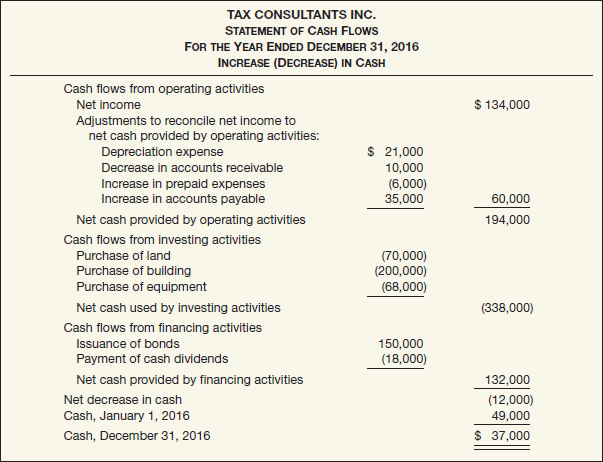
Illustration–2017
Our third example, covering the 2017 operations of Tax Consultants Inc., is more complex. It again uses the indirect method to compute and present net cash flow from operating activities.
Tax Consultants Inc. experienced continued success in 2017 and expanded its operations to include the sale of computer software used in tax-return preparation and tax planning. Thus, inventory is a new asset appearing in the company's December 31, 2017, statement of financial position. Illustrations 23-13 and 23-14 (on page 1194) show the comparative statements of financial position, income statements, and selected data for 2017.
Step 1: Determine the Change in Cash
The first step in the preparation of the statement of cash flows is to determine the change in cash. As the comparative statements of financial position show, cash increased $17,000 in 2017.
ILLUSTRATION 23-13
Comparative Statements of Financial Position, Tax Consultants Inc., Year 3
ILLUSTRATION 23-14
Income Statement, Tax Consultants Inc., Year 3
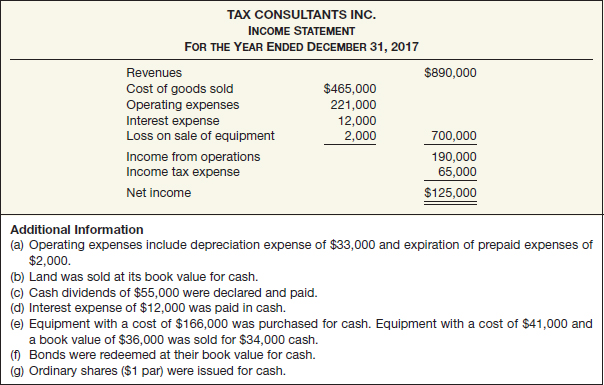
Step 2: Determine Net Cash Flow from Operating Activities–Indirect Method
We explain the adjustments to net income of $125,000 as follows.
Increase in Accounts Receivable. The increase in accounts receivable of $42,000 represents recorded accrual-basis revenues in excess of cash collections in 2017. The company deducts this increase from net income to convert from the accrual basis to the cash basis.
Increase in Inventories. The $54,000 increase in inventories represents an operating use of cash, not an expense. Tax Consultants therefore deducts this amount from net income, to arrive at net cash flow from operations. In other words, when inventory purchased exceeds inventory sold during a period, cost of goods sold on an accrual basis is lower than on a cash basis.
Decrease in Prepaid Expenses. The $2,000 decrease in prepaid expenses represents a charge to the income statement for which Tax Consultants made no cash payment in the current period. The company adds back the decrease to net income, to arrive at net cash flow from operating activities.
Decrease in Accounts Payable. When accounts payable decrease during the year, cost of goods sold and expenses on a cash basis are higher than they are on an accrual basis. To convert net income to net cash flow from operating activities, the company must deduct the $7,000 in accounts payable from net income.
Depreciation Expense (Increase in Accumulated Depreciation). Accumulated Depreciation—Buildings increased $10,000 ($21,000 − $11,000). The Buildings account did not change during the period, which means that Tax Consultants recorded depreciation expense of $10,000 in 2017.
Accumulated Depreciation—Equipment increased by $18,000 ($28,000 − $10,000) during the year. But Accumulated Depreciation—Equipment decreased by $5,000 as a result of the sale during the year. Thus, depreciation for the year was $23,000. The company reconciled Accumulated Depreciation—Equipment as follows.

The company must add back to net income the total depreciation of $33,000 ($10,000 + $23,000) charged to the income statement, to determine net cash flow from operating activities.
Loss on Sale of Equipment. Tax Consultants sold for $34,000 equipment that cost $41,000 and had a book value of $36,000. As a result, the company reported a loss of $2,000 on its sale. To arrive at net cash flow from operating activities, it must add back to net income the loss on the sale of the equipment. The reason is that the loss is a non-cash charge to the income statement. The loss did not reduce cash, but it did reduce net income.
From the foregoing items, the company prepares the operating activities section of the statement of cash flows, as shown in Illustration 23-15.
ILLUSTRATION 23-15
Operating Activities Section of Cash Flow Statement

Step 3: Determine Net Cash Flows from Investing and Financing Activities
By analyzing the remaining changes in the statement of financial position accounts, Tax Consultants identifies cash flows from investing and financing activities.
Land. Land decreased $25,000 during the period. As indicated from the information presented, the company sold land for cash at its book value. This transaction is an investing activity, reported as a $25,000 source of cash.
Equipment. An analysis of the Equipment account indicates the following.

The company used cash to purchase equipment with a fair value of $166,000—an investing transaction reported as a cash outflow. The sale of the equipment for $34,000 is also an investing activity, but one that generates a cash inflow.
Bonds Payable. Bonds payable decreased $40,000 during the year. As indicated from the additional information, the company redeemed the bonds at their book value. This financing transaction used $40,000 of cash.
Share Capital—Ordinary. The Share Capital—Ordinary account increased $160,000 during the year. As indicated from the additional information, Tax Consultants issued ordinary shares of $160,000 at par. This financing transaction provided cash of $160,000.
Retained Earnings. Retained earnings changed $70,000 ($206,000 − $136,000) during the year. The $70,000 change in retained earnings results from net income of $125,000 from operations and the financing activity of paying cash dividends of $55,000.
Statement of Cash Flows–2017
Tax Consultants Inc. combines the foregoing items to prepare the statement of cash flows shown in Illustration 23-16.
ILLUSTRATION 23-16
Statement of Cash Flows, Tax Consultants Inc., Year 3
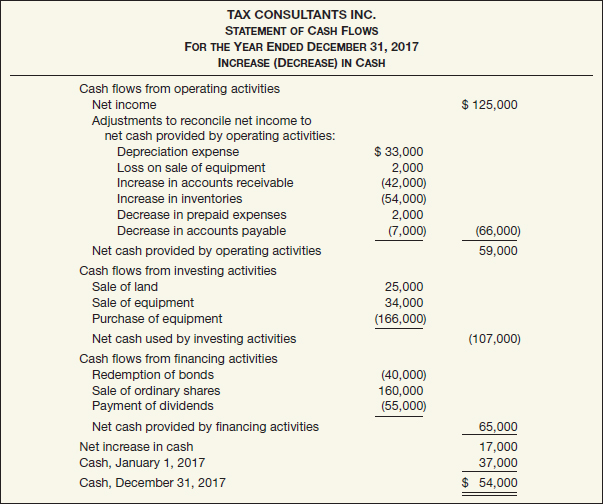
Sources of Information for the Statement of Cash Flows
Important points to remember in the preparation of the statement of cash flows are these:
![]() LEARNING OBJECTIVE
LEARNING OBJECTIVE
Identify sources of information for a statement of cash flows.
- 1. Comparative statements of financial position provide the basic information from which to prepare the report. Additional information obtained from analyses of specific accounts is also included.
- 2. An analysis of the Retained Earnings account is necessary. The net increase or decrease in Retained Earnings without any explanation is a meaningless amount in the statement. Without explanation, it might represent the effect of net income, dividends declared, or prior period adjustments.
- 3. The statement includes all changes that have passed through cash or have resulted in an increase or decrease in cash.
- 4. Write-downs, amortization charges, and similar “book” entries, such as depreciation of plant assets, represent neither inflows nor outflows of cash because they have no effect on cash. To the extent that they have entered into the determination of net income, however, the company must add them back to or subtract them from net income, to arrive at net cash provided (used) by operating activities.
Indirect Method–Additional Adjustments
For consistency and comparability and because it is the most widely used method in practice, we used the indirect method in the Tax Consultants' illustrations. We determined net cash flow from operating activities by adding back to or deducting from net income those items that had no effect on cash. Illustration 23-17 presents a more complete set of common types of adjustments that companies make to net income to arrive at net cash flow from operating activities.
ILLUSTRATION 23-17
Adjustments Needed to Determine Net Cash Flow from Operating Activities—Indirect Method

The additions and deductions in Illustration 23-17 reconcile net income to net cash flow from operating activities, illustrating why the indirect method is also called the reconciliation method.
Net Cash Flow from Operating Activities–Direct Method
Two different methods are available to adjust income from operations on an accrual basis to net cash flow from operating activities. We showed the indirect method in the Tax Consultants' illustrations in the prior sections.
![]() LEARNING OBJECTIVE
LEARNING OBJECTIVE
Contrast the direct and indirect methods of calculating net cash flow from operating activities.
The direct method reports cash receipts and cash disbursements from operating activities. The difference between these two amounts is the net cash flow from operating activities. In other words, the direct method deducts operating cash disbursements from operating cash receipts. The direct method results in the presentation of a condensed cash receipts and cash disbursements statement.
As indicated from the accrual-based income statement (see Illustration 23-4 on page 1187), Tax Consultants reported revenues of $125,000. However, because the company's accounts receivable increased during 2015 by $36,000, the company collected only $89,000 ($125,000 − $36,000) in cash from these revenues. Similarly, Tax Consultants reported operating expenses of $85,000. However, accounts payable increased during the period by $5,000. Assuming that these payables relate to operating expenses, cash operating expenses were $80,000 ($85,000 − $5,000). Because no taxes payable exist at the end of the year, the company must have paid $6,000 income tax expense for 2015 in cash during the year. Tax Consultants computes net cash flow from operating activities as shown in Illustration 23-18.
ILLUSTRATION 23-18
Computation of Net Cash Flow from Operating Activities, Year 1—Direct Method

“Net cash provided by operating activities” is the equivalent of cash basis net income. (“Net cash used by operating activities” is equivalent to cash basis net loss.)
The IASB encourages use of the direct method and permits use of the indirect method. Yet, if the direct method is used, the Board requires that companies provide in a separate schedule a reconciliation of net income to net cash flow from operating activities. Therefore, under either method, companies must prepare and report information from the indirect (reconciliation) method.
Direct Method–An Example
Under the direct method, the statement of cash flows reports net cash flow from operating activities as major classes of operating cash receipts (e.g., cash collected from customers and cash received from interest and dividends) and cash disbursements (e.g., cash paid to suppliers for goods, to employees for services, to creditors for interest, and to government authorities for taxes).
We illustrate the direct method here in more detail to help you understand the difference between accrual-based income and net cash flow from operating activities. This example also illustrates the data needed to apply the direct method. Drogba Company, which began business on January 1, 2015, has the following selected statement of financial position information.
ILLUSTRATION 23-19
Statement of Financial Position Accounts, Drogba Co.

Drogba's December 31, 2015, income statement and additional information are as follows.
ILLUSTRATION 23-20
Income Statement, Drogba Co.

Under the direct method, companies compute net cash provided by operating activities by adjusting each item in the income statement from the accrual basis to the cash basis. To simplify and condense the operating activities section, only major classes of operating cash receipts and cash payments are reported. As Illustration 23-21 shows, the difference between these major classes of cash receipts and cash payments is the net cash provided by operating activities.

ILLUSTRATION 23-21
Major Classes of Cash Receipts and Payments
An efficient way to apply the direct method is to analyze the revenues and expenses reported in the income statement in the order in which they are listed. The company then determines cash receipts and cash payments related to these revenues and expenses. In the following sections, we present the direct method adjustments for Drogba Company in 2016, to determine net cash provided by operating activities.
Cash Receipts from Customers. The income statement for Drogba Company reported revenues from customers of €780,000. To determine cash receipts from customers, the company considers the change in accounts receivable during the year.
When accounts receivable increase during the year, revenues on an accrual basis are higher than cash receipts from customers. In other words, operations led to increased revenues, but not all of these revenues resulted in cash receipts. To determine the amount of cash receipts, deduct the amount of the increase in accounts receivable from the total sales revenues. Conversely, a decrease in accounts receivable is added to sales revenues because cash receipts from customers then exceed sales revenues.
For Drogba, accounts receivable increased €15,000. Thus, cash receipts from customers were €765,000, computed as follows.

Drogba could also determine cash receipts from customers by analyzing the Accounts Receivable account, as shown below.

Illustration 23-22 shows the relationships between cash receipts from customers, revenues from sales, and changes in accounts receivable.
ILLUSTRATION 23-22
Formula to Compute Cash Receipts from Customers

Cash Payments to Suppliers. Drogba Company reported cost of goods sold on its income statement of €450,000. To determine cash payments to suppliers, the company first finds purchases for the year, by adjusting cost of goods sold for the change in inventory. When inventory increases during the year, purchases this year exceed cost of goods sold. As a result, the company adds the increase in inventory to cost of goods sold, to arrive at purchases.
In 2016, Drogba Company's inventory increased €160,000. The company computes purchases as follows.

After computing purchases, Drogba determines cash payments to suppliers by adjusting purchases for the change in accounts payable. When accounts payable increase during the year, purchases on an accrual basis are higher than they are on a cash basis. As a result, it deducts from purchases the increase in accounts payable to arrive at cash payments to suppliers. Conversely, if cash payments to suppliers exceed purchases, Drogba adds to purchases the decrease in accounts payable. Cash payments to suppliers were €550,000, computed as follows.
Drogba also can determine cash payments to suppliers by analyzing Accounts Payable, as shown below.

Illustration 23-23 shows the relationships between cash payments to suppliers, cost of goods sold, changes in inventory, and changes in accounts payable.
ILLUSTRATION 23-23
Formula to Compute Cash Payments to Suppliers

Cash Payments for Operating Expenses. Drogba reported operating expenses of €160,000 on its income statement. To determine the cash paid for operating expenses, it must adjust this amount for any changes in prepaid expenses and accrued expenses payable.
For example, when prepaid expenses increased €8,000 during the year, cash paid for operating expenses was €8,000 higher than operating expenses reported on the income statement. To convert operating expenses to cash payments for operating expenses, the company adds to operating expenses the increase of €8,000. Conversely, if prepaid expenses decrease during the year, Drogba deducts from operating expenses the amount of the decrease.
Drogba also must adjust operating expenses for changes in accrued expenses payable. When accrued expenses payable increase during the year, operating expenses on an accrual basis are higher than they are on a cash basis. As a result, the company deducts from operating expenses an increase in accrued expenses payable, to arrive at cash payments for operating expenses. Conversely, it adds to operating expenses a decrease in accrued expenses payable because cash payments exceed operating expenses.
Drogba's cash payments for operating expenses were €148,000, computed as follows.

The relationships among cash payments for operating expenses, changes in prepaid expenses, and changes in accrued expenses payable are shown in Illustration 23-24.
ILLUSTRATION 23-24
Formula to Compute Cash Payments for Operating Expenses

Note that the company did not consider depreciation expense because it is a non-cash charge.
Cash Payments for Income Taxes. The income statement for Drogba shows income tax expense of €48,000. This amount equals the cash paid. How do we know that? Because the comparative statement of financial position indicated no income taxes payable at either the beginning or end of the year.
Summary of Net Cash Flow from Operating Activities–Direct Method
The following schedule summarizes the computations illustrated above.
ILLUSTRATION 23-25
Accrual Basis to Cash Basis

Illustration 23-26 shows the presentation of the direct method for reporting net cash flow from operating activities for the Drogba Company example.
ILLUSTRATION 23-26
Operating Activities Section—Direct Method, 2016

If Drogba uses the direct method to present the net cash flow from operating activities, it is required to provide in a separate schedule the reconciliation of net income to net cash provided by operating activities. The reconciliation assumes the identical form and content of the indirect method of presentation, as shown below.
ILLUSTRATION 23-27
Reconciliation of Net Income to Net Cash Provided by Operating Activities, 2016

![]() Evolving Issue DIRECT VERSUS INDIRECT
Evolving Issue DIRECT VERSUS INDIRECT
A contentious decision that the IASB faced related to cash flow reporting was choosing between the direct method and the indirect method of determining net cash flow from operating activities. Companies lobbied against the direct method, urging adoption of the indirect method. Commercial lending officers expressed to the IASB a strong preference in favor of the direct method. What are the arguments in favor of each of the methods?
In Favor of the Direct Method
The principal advantage of the direct method is that it shows operating cash receipts and payments. Thus, it is more consistent with the objective of a statement of cash flows—to provide information about cash receipts and cash payments—than the indirect method, which does not report operating cash receipts and payments.
Supporters of the direct method contend that knowledge of the specific sources of operating cash receipts and the purposes for which operating cash payments were made in past periods is useful in estimating future operating cash flows. Furthermore, information about amounts of major classes of operating cash receipts and payments is more useful than information only about their arithmetic sum (the net cash flow from operating activities). Such information is more revealing of a company's ability (1) to generate sufficient cash from operating activities to pay its debts, (2) to reinvest in its operations, and (3) to make distributions to its owners.
Many companies indicate that they do not currently collect information in a manner that allows them to determine amounts such as cash received from customers or cash paid to suppliers directly from their accounting systems. But supporters of the direct method contend that the incremental cost of determining operating cash receipts and payments is not significant.
In Favor of the Indirect Method
The principal advantage of the indirect method is that it focuses on the differences between net income and net cash flow from operating activities. That is, it provides a useful link between the statement of cash flows and the income statement and statement of financial position.
Many companies contend that it is less costly to adjust net income to net cash flow from operating activities (indirect) than it is to report gross operating cash receipts and payments (direct). Supporters of the indirect method also state that the direct method, which effectively reports income statement information on a cash rather than an accrual basis, may erroneously suggest that net cash flow from operating activities is as good as, or better than, net income as a measure of performance.
In their joint financial statement presentation project, the IASB and the FASB have proposed to allow only the direct method. However, there has been significant pushback on this proposal, which suggests that the choice of either the direct or indirect method will continue to be available.
Source: See http://www.fasb.org; click on Projects and then on Inactive Joint FASB/IASB Projects.
SPECIAL PROBLEMS IN STATEMENT PREPARATION
We discussed some of the special problems related to preparing the statement of cash flows in connection with the preceding illustrations. Other problems that arise with some frequency in the preparation of this statement include the following.
![]() LEARNING OBJECTIVE
LEARNING OBJECTIVE
Discuss special problems in preparing a statement of cash flows.
- 1. Adjustments to net income.
- 2. Accounts receivable (net).
- 3. Other working capital changes.
- 4. Net loss.
- 5. Disclosures.
Adjustments to Net Income
Depreciation and Amortization
Depreciation expense is the most common adjustment to net income that companies make to arrive at net cash flow from operating activities. But there are numerous other non-cash expense or revenue items. Examples of expense items that companies must add back to net income are the amortization of limited-life intangible assets, such as patents, and depletion of mineral resources. These charges to expense involve expenditures made in prior periods that a company amortizes currently. These charges reduce net income without affecting cash in the current period.
Also, amortization of bond discount or premium on long-term bonds payable affects the amount of interest expense. However, neither changes cash. As a result, a company should add back discount amortization and subtract premium amortization from net income to arrive at net cash flow from operating activities.
Postretirement Benefit Costs
If a company has postretirement costs such as an employee pension plan, chances are that the pension expense recorded during a period will either be higher or lower than the cash funded. It will be higher when there is an unfunded liability and will be lower when there is a prepaid pension cost. When the expense is higher or lower than the cash paid, the company must adjust net income by the difference between cash paid and the expense reported in computing net cash flow from operating activities.
Change in Deferred Income Taxes
Changes in deferred income taxes affect net income but have no effect on cash. For example, Baytex Energy Corp. (CAN) reported an increase in its liability for deferred taxes of approximately $107,598,000. This change in the liability increased tax expense and decreased net income, but did not affect cash. Therefore, Baytex added back $107,598,000 to net income on its statement of cash flows.
Equity Method of Accounting
Another common adjustment to net income is a change related to an investment in ordinary shares when recording income or loss under the equity method. Recall that under the equity method, the investor (1) debits the investment account and credits revenue for its share of the investee's net income, and (2) credits dividends received to the investment account. Therefore, the net increase in the investment account does not affect cash flows. A company must deduct the net increase from net income to arrive at net cash flow from operating activities.
Assume that Victor Co. owns 40 percent of Milo Inc. During the year, Milo reports net income of $100,000 and pays a cash dividend of $30,000. Victor reports this in its statement of cash flows as a deduction from net income in the following manner—Equity in earnings of Milo, net of dividends, $28,000 [($100,000 − $30,000) × 40%].
Losses and Gains
Realized Losses and Gains. In the illustration for Tax Consultants, the company experienced a loss of $2,000 from the sale of equipment. The company added this loss to net income to compute net cash flow from operating activities because the loss is a non-cash charge in the income statement.
If Tax Consultants experiences a gain from a sale of equipment, it too requires an adjustment to net income. Because a company reports the gain in the statement of cash flows as part of the cash proceeds from the sale of equipment under investing activities, it deducts the gain from net income to avoid double-counting—once as part of net income and again as part of the cash proceeds from the sale.
To illustrate, assume that Tax Consultants had land with a carrying value of $200,000, which was condemned by the provincial government for a highway project. The condemnation proceeds received were $205,000, resulting in a gain of $5,000. In the statement of cash flows (indirect method), the company would deduct the $5,000 gain from net income in the operating activities section. It would report the $205,000 cash inflow from the condemnation as an investing activity, as follows.
![]()
Unrealized Losses and Gains. Unrealized losses and gains generally occur for debt investments not held for collection and for equity investments. For example, assume that AB InBev (BEL) purchases the following two security investments on January 10, 2015.
- 1. Debt investment for €1 million that is classified as trading. During 2015, the debt investment has an unrealized holding gain of €110,000 (recorded in net income).
- 2. Equity investment for €600,000 that is non-trading in nature. During 2015, the non-trading equity investment has an unrealized holding loss of €50,000 (recorded in other comprehensive income).
For AB InBev, the unrealized holding gain of €110,000 on the debt investment increases net income but does not increase net cash flow from operating activities. As a result, the unrealized holding gain of €110,000 is deducted from net income to compute net cash flow from operating activities.
On the other hand, the unrealized holding loss of €50,000 that AB InBev incurs on the non-trading equity investment does not affect net income or cash flows—this loss is reported in the other comprehensive income section. As a result, no adjustment to net income is necessary in computing net cash flow from operating activities.
Thus, the general rule is that unrealized holding gains or losses that affect net income must be adjusted to determine net cash flow from operating activities. Conversely, unrealized holding gains or losses that do not affect net income are not adjusted to determine net cash flow from operating activities.4
Share-Based Compensation
Recall for share-based compensation plans that companies are required to use the fair value method to determine total compensation cost. The compensation cost is then recognized as an expense in the periods in which the employee provides services. When Compensation Expense is debited, Share Premium—Options is often credited. Cash is not affected by recording the expense. Therefore, the company must increase net income by the amount of compensation expense from share options in computing net cash flow from operating activities.
To illustrate how this information should be reported on a statement of cash flows, assume that First Wave Inc. grants 5,000 options to its CEO, Ann Johnson. Each option entitles Johnson to purchase one share of First Wave's £1 par value ordinary shares at £50 per share at any time in the next two years (the service period). The fair value of the options is £200,000. First Wave records compensation expense in the first year as follows.
![]()
In addition, if we assume that First Wave has a 35 percent tax rate, it would recognize a deferred tax asset of £35,000 (£100,000 × 35%) in the first year, as follows.
![]()
Therefore, on the statement of cash flows for the first year, First Wave reports the following (assuming a net income of £600,000).

As shown in First Wave's statement of cash flows, it adds the share-based compensation expense to net income because it is a non-cash expense. The increase in the deferred tax asset and the related reduction in income tax expense increase net income. Although the negative income tax expense increases net income, it does not increase cash. Therefore, it should be deducted. Subsequently, if Ann Johnson exercises her options, Third Wave reports “Cash provided by exercise of share options” in the financing section of the statement of cash flows.5
Accounts Receivable (Net)
Up to this point, we assumed no allowance for doubtful accounts—a contra account—to offset accounts receivable. However, if a company needs an allowance for doubtful accounts, how does that allowance affect the company's determination of net cash flow from operating activities? For example, assume that Redmark Co. reports net income of €40,000. It has the accounts receivable balances, as shown in Illustration 23-28.
ILLUSTRATION 23-28
Accounts Receivable Balances, Redmark Co.

Indirect Method
Because an increase in Allowance for Doubtful Accounts results from a charge to bad debt expense, a company should add back an increase in Allowance for Doubtful Accounts to net income to arrive at net cash flow from operating activities. Illustration 23-29 shows one method for presenting this information in a statement of cash flows.
ILLUSTRATION 23-29
Presentation of Allowance for Doubtful Accounts—Indirect Method

As we indicated, the increase in the Allowance for Doubtful Accounts balance results from a charge to bad debt expense for the year. Because bad debt expense is a non-cash charge, a company must add it back to net income in arriving at net cash flow from operating activities.
Instead of separately analyzing the allowance account, a short-cut approach is to net the allowance balance against the receivable balance and compare the change in accounts receivable on a net basis. Illustration 23-30 shows this presentation.
ILLUSTRATION 23-30
Net Approach to Allowance for Doubtful Accounts—Indirect Method

This short-cut procedure works also if the change in the allowance account results from a write-off of accounts receivable. This reduces both Accounts Receivable and Allowance for Doubtful Accounts. No effect on cash flows occurs. Because of its simplicity, use the net approach for your homework assignments.
Direct Method
If using the direct method, a company should not net Allowance for Doubtful Accounts against Accounts Receivable. To illustrate, assume that Redmark Co.'s net income of €40,000 consisted of the following items.
ILLUSTRATION 23-31
Income Statement, Redmark Co.

If Redmark deducts the €9,000 increase in accounts receivable (net) from sales for the year, it would report cash sales at €91,000 (€100,000 − €9,000) and cash payments for operating expenses at €60,000. Both items would be misstated: Cash sales should be reported at €85,000 (€100,000 − €15,000), and total cash payments for operating expenses should be reported at €54,000 (€60,000 − €6,000). Illustration 23-32 shows the proper presentation.
ILLUSTRATION 23-32
Bad Debts—Direct Method

An added complication develops when a company writes off accounts receivable. Simply adjusting sales for the change in accounts receivable will not provide the proper amount of cash sales. The reason is that the write-off of the accounts receivable is not a cash collection. Thus, an additional adjustment is necessary.
Other Working Capital Changes
Up to this point, we showed how companies handled all of the changes in working capital items (current asset and current liability items) as adjustments to net income in determining net cash flow from operating activities. You must be careful, however, because some changes in working capital, although they affect cash, do not affect net income. Generally, these are investing or financing activities of a current nature.
One activity is the purchase of short-term non-trading equity investments. For example, the purchase of short-term non-trading equity investments for ¥5,000,000 cash has no effect on net income, but it does cause a ¥5,000,000 decrease in cash. A company reports this transaction as a cash flow from investing activities as follows.
![]()
Another example is the issuance of a short-term non-trade note payable for cash. This change in a working capital item has no effect on income from operations, but it increases cash by the amount of the note payable. For example, a company reports the issuance of a ¥10,000,000 short-term, non-trade note payable for cash in the statement of cash flows as follows.
![]()
Another change in a working capital item that has no effect on income from operations or on cash is a cash dividend payable. Although a company will report the cash dividends when paid as a financing activity, it does not report the declared but unpaid dividend on the statement of cash flows.
Net Losses
If a company reports a net loss instead of a net income, it must adjust the net loss for those items that do not result in a cash inflow or outflow. The net loss, after adjusting for the charges or credits not affecting cash, may result in a negative or a positive cash flow from operating activities.
For example, if the net loss is £50,000 and the total amount of charges to add back is £60,000, then net cash provided by operating activities is £10,000. Illustration 23-33 shows this computation.
ILLUSTRATION 23-33
Computation of Net Cash Flow from Operating Activities—Cash Inflow

If the company experiences a net loss of £80,000 and the total amount of the charges to add back is £25,000, the presentation appears as follows.
ILLUSTRATION 23-34
Computation of Net Cash Flow from Operating Activities—Cash Outflow

Although not illustrated in this chapter, a negative cash flow may result even if the company reports a net income.
Disclosures
Significant Non-Cash Transactions
Because the statement of cash flows reports only the effects of operating, investing, and financing activities in terms of cash flows, it omits some significant non-cash transactions and other events that are investing or financing activities. Among the more common of these non-cash transactions that a company should report or disclose in some manner are the following.
- 1. Acquisition of assets by assuming liabilities (including finance lease obligations) or by issuing equity securities.
- 2. Exchanges of non-monetary assets.
- 3. Refinancing of long-term debt.
- 4. Conversion of debt or preference shares to ordinary shares.
- 5. Issuance of equity securities to retire debt.
Investing and financing transactions that do not require the use of cash are excluded from the statement of cash flows. [6] If material in amount, these disclosures may be either narrative or summarized in a separate schedule. This schedule may appear in a separate note or supplementary schedule to the financial statements.6 Illustration 23-35 (on page 1210) shows the presentation of these significant non-cash transactions or other events in a separate schedule in the notes to the financial statements.
ILLUSTRATION 23-35
Note Presentation of Non-Cash Investing and Financing Activities
Companies do not generally report certain other significant non-cash transactions or other events in conjunction with the statement of cash flows. Examples of these types of transactions are share dividends, share splits, and restrictions on retained earnings. Companies generally report these items, neither financing nor investing activities, in conjunction with the statement of changes in equity or schedules and notes pertaining to changes in equity accounts.
Special Disclosures
IAS 7 indicates that cash flows related to interest received and paid, and dividends received and paid, should be separately disclosed in the statement of cash flows. [7] Each item should be classified in a consistent manner from period to period as operating, investing, or financing cash flows. As indicated earlier, for homework purposes classify interest received and paid and dividends received as part of cash flows from operating activities and dividends paid as cash flows from financing activities. The justification for reporting the first three items in cash flows from operating activities is that each item affects net income. Dividends paid, however, do not affect net income and are often considered a cost of financing.
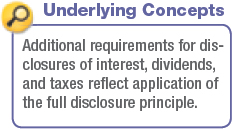
Companies should also disclose income taxes paid separately in the cash flows from operating activities unless they can be separately identified as part of investing or financing activities. While tax expense may be readily identifiable with investing or financing activities, the related tax cash flows are often impracticable to identify and may arise in a different period from the cash flows of the underlying transaction. Therefore, taxes paid are usually classified as cash flows from operating activities. IFRS requires that the cash paid for taxes, as well as cash flows from interest and dividends received and paid, be disclosed. The category (operating, investing, or financing) in which each item was included must be disclosed as well.
An example of such a disclosure from the notes to Daimler's (DEU) financial statement is provided in Illustration 23-36.
ILLUSTRATION 23-36
Note Disclosure of Interest, Taxes, and Dividends

Other companies choose to report these items directly in the statement of cash flows. In many cases, companies start with income before income taxes and then show income taxes paid as a separate item. In addition, they often add back interest expense on an accrual basis and then subtract interest paid. Reporting these items in the operating activites section is shown for Wáng Company in Illustration 23-37.
ILLUSTRATION 23-37
Reporting of Interest, Taxes, and Dividends in the Operating Section
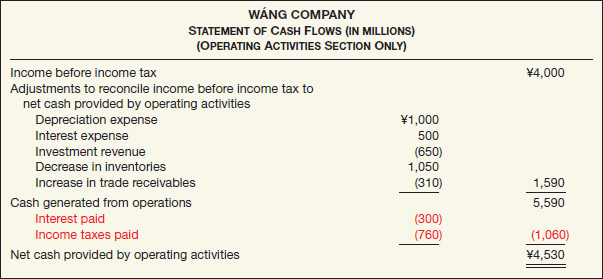
Companies often provide a separate section to identify interest and income taxes paid.
What do the numbers mean? BETTER THAN ROA?
As you have learned in your study of accounting, both accounting income (measured under accrual-accounting principles) and cash flow from operations can provide useful information. However, both measures are sometimes criticized. Accounting income is sometimes faulted for the multitude of judgments required to determine revenues and expenses. In addition, many companies can boost an earnings-based metric, return on equity, by piling on debt which also makes the company riskier, not better. On the other hand, cash flow performance metrics are criticized because they do not follow the revenue and expense recognition principles.
So what's a better way to measure how profitable companies really are? Or, adopting master investor Warren Buffett's view of investing: How do you find companies that consistently generate big returns on invested capital? Recently, a new measure of profitability, “COROA”—for cash operating return on assets—has been proposed to provide a better performance metric. The idea is to measure management's ability to generate pure cash returns, not cash expected in the future, on every dollar invested in property, plant, and equipment; R&D centers; inventories; and all other assets.
Specifically, COROA is computed by starting with the cash flow from operations amount and then adding back cash taxes and cash interest to calculate pure operating cash flows. That's the dollar amount that the company actually puts in its coffers during the year—and which could be used to pay dividends, make “investments” by purchasing companies or divisions, and fund capital expenditures, especially those that propel growth. That's the numerator. Adjustments for taxes and interest are fundamental to this COROA measure. This is because falling taxes can create the illusion of ongoing progress. Interest is added back because it primarily reflects the level of leverage but has nothing to do with how well management is managing their assets.
The denominator consists of every dollar spent on the assets that produce those operating cash flows. To calculate that figure, take “total assets” from the statement of financial position and add “accumulated depreciation” to account for operating assets that are still being used to make cars, semiconductors, or other products that, for accounting purposes, are fully expensed.
Thus, COROA—adjusted cash flow from operations as a percentage of total assets—is the ratio to keep an eye on. It's the best measure of pure profitability. If the number has been high for a while and is either staying high or improving, evidence is strong that the company is generating strong returns from its new investments. That's the quality that Buffett looks for. And according to accounting guru Jack Ciesielski, it's all about cash. “What's more important in the world than cash?” he asks. “Why, it's more cash, of course.”
Source: S. Tully, “A Top Accounting Guru's Compelling New Measure for Profitability,” Fortune (March 10, 2014).
USE OF A WORKSHEET
LEARNING OBJECTIVE ![]()
Explain the use of a worksheet in preparing a statement of cash flows.
When numerous adjustments are necessary or other complicating factors are present, companies often use a worksheet to assemble and classify the data that will appear on the statement of cash flows. The worksheet is merely a device that aids in the preparation of the statement. Its use is optional. Illustration 23-38 shows the skeleton format of the worksheet for preparation of the statement of cash flows using the indirect method.
ILLUSTRATION 23-38
Format of Worksheet for Preparation of Statement of Cash Flows

The following guidelines are important in using a worksheet.
- 1. In the statement of financial position accounts section, list accounts with debit balances separately from those with credit balances. This means, for example, that Accumulated Depreciation is listed under credit balances and not as a contra account under debit balances. Enter the beginning and ending balances of each account in the appropriate columns. Then, enter the transactions that caused the change in the account balance during the year as reconciling items in the two middle columns.
After all reconciling items have been entered, each line pertaining to a statement of financial position account should foot across. That is, the beginning balance plus or minus the reconciling item(s) must equal the ending balance. When this agreement exists for all statement of financial position accounts, all changes in account balances have been reconciled.
- 2. The bottom portion of the worksheet consists of the operating, investing, and financing activities sections. Accordingly, it provides the information necessary to prepare the formal statement of cash flows. Enter inflows of cash as debits in the reconciling columns, and outflows of cash as credits in the reconciling columns. Thus, in this section, a company would enter the sale of equipment for cash at book value as a debit under inflows of cash from investing activities. Similarly, it would enter the purchase of land for cash as a credit under outflows of cash from investing activities.
- 3. Do not enter in any journal or post to any account the reconciling items shown in the worksheet. These items do not represent either adjustments or corrections of the statement of financial position accounts. They are used only to facilitate the preparation of the statement of cash flows.
Preparation of the Worksheet
The preparation of a worksheet involves the following steps.
Step 1. Enter the statement of financial position accounts and their beginning and ending balances in the statement of financial position accounts section.
Step 2. Enter the data that explain the changes in the statement of financial position accounts (other than cash) and their effects on the statement of cash flows in the reconciling columns of the worksheet.
Step 3. Enter the increase or decrease in cash on the cash line and at the bottom of the worksheet. This entry should enable the totals of the reconciling columns to be in agreement.
To illustrate the preparation and use of a worksheet and to illustrate the reporting of some of the special problems discussed in the prior section, we present a comprehensive example for Satellite Corporation. Again, the indirect method serves as the basis for the computation of net cash provided by operating activities. Illustrations 23-39 and 23-40 (on pages 1214 and 1215) present the statement of financial position, combined statement of income and retained earnings, and additional information for Satellite Corporation. The discussion that follows these financial statements provides additional explanations related to the preparation of the worksheet.
Analysis of Transactions
The following discussion explains the individual adjustments that appear on the worksheet in Illustration 23-41 (page 1219). Because cash is the basis for the analysis, Satellite reconciles the cash account last. Because income is the first item that appears on the statement of cash flows, it is handled first.
Change in Retained Earnings
Net income for the period is HK$117,000. The entry for it on the worksheet is as follows.
![]()
Satellite reports net income on the bottom section of the worksheet. This is the starting point for preparation of the statement of cash flows (under the indirect method).
A share dividend and a cash dividend also affected retained earnings. The retained earnings statement reports a share dividend of HK$15,000. The worksheet entry for this transaction is as follows.
ILLUSTRATION 23-39
Comparative Statement of Financial Position, Satellite Corporation


The issuance of share dividends is not a cash operating, investing, or financing item. Therefore, although the company enters this transaction on the worksheet for reconciling purposes, it does not report it in the statement of cash flows.
The HK$6,000 cash dividend paid represents a financing activity cash outflow. Satellite makes the following worksheet entry:

The company reconciles the beginning and ending balances of retained earnings by entry of the three items above.
ILLUSTRATION 23-40
Income and Retained Earnings Statements, Satellite Corporation
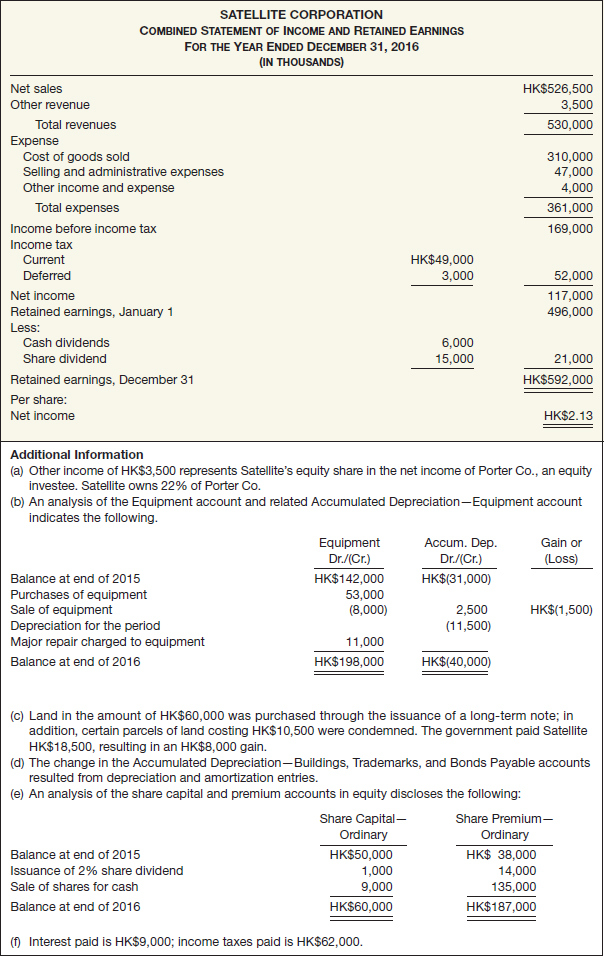
Accounts Receivable (Net)
The increase in accounts receivable (net) of HK$53,000 represents adjustments that did not result in cash inflows during 2016. As a result, the company would deduct from net income the increase of HK$53,000. Satellite makes the following worksheet entry.
![]()
Inventory
The increase in inventory of HK$152,000 represents an operating use of cash. The incremental investment in inventory during the year reduces cash without increasing the cost of goods sold. Satellite makes the following worksheet entry.
![]()
Prepaid Expense
The decrease in prepaid expenses of HK$500 represents a charge in the income statement for which there was no cash outflow in the current period. Satellite should add that amount back to net income through the following entry.
![]()
Equity Investment in Porter Co. (Equity Method)
Satellite's investment in the shares of Porter Co. increased HK$3,500. This amount reflects Satellite's share of net income earned by Porter (its equity investee) during the current year. Although Satellite's revenue, and therefore its net income, increased HK$3,500 by recording Satellite's share of Porter Co.'s net income, no cash (dividend) was provided. Satellite makes the following worksheet entry.
![]()
Land
Satellite purchased land in the amount of HK$60,000 through the issuance of a long-term note payable. This transaction did not affect cash. It is a significant non-cash investing/financing transaction that the company would disclose in the accompanying notes. Satellite makes the following entry to reconcile the worksheet.
![]()
In addition to the non-cash transaction involving the issuance of a note to purchase land, the Land account was decreased by the condemnation proceedings. The following worksheet entry records the receipt of HK$18,500 for land having a book value of HK$10,500.

In reconciling net income to net cash flow from operating activities, Satellite deducts from net income the gain of HK$8,000. The reason is that the transaction that gave rise to the gain is an item whose cash effect is already classified as an investing cash inflow. The Land account is now reconciled.
Equipment and Accumulated Depreciation–Equipment
An analysis of Equipment and Accumulated Depreciation—Equipment shows that a number of transactions have affected these accounts. The company purchased equipment in the amount of HK$53,000 during the year. Satellite records this transaction on the worksheet as follows.
![]()
In addition, Satellite sold at a loss of HK$1,500 equipment with a book value of HK$5,500. It records this transaction as follows.

The proceeds from the sale of the equipment provided cash of HK$4,000. In addition, the loss on the sale of the equipment has reduced net income but did not affect cash. Therefore, the company adds back to net income the amount of the loss, in order to accurately report cash provided by operating activities.

Satellite reported depreciation on the equipment at HK$11,500 and recorded it on the worksheet as follows.
![]()
The company adds depreciation expense back to net income because that expense reduced income but did not affect cash.

Finally, the company made a major repair to the equipment. It charged this expenditure, in the amount of HK$11,000, to the Equipment account. This expenditure required cash, and so Satellite makes the following worksheet entry.
![]()
After adjusting for the foregoing items, Satellite has reconciled the balances in the Equipment and related Accumulated Depreciation—Equipment accounts.
Building Depreciation and Amortization of Trademarks
Depreciation expense on the buildings of HK$3,100 and amortization of trademarks of HK$2,400 are both expenses in the income statement that reduced net income but did not require cash outflows in the current period. Satellite makes the following worksheet entry.

Other Non-Cash Charges or Credits
Analysis of the remaining accounts indicates that changes in the Accounts Payable, Accrued Liabilities, Income Taxes Payable, Bonds Payable, and Deferred Tax Liability balances resulted from charges or credits to net income that did not affect cash. The company should individually analyze each of these items and enter them in the worksheet. The following compound entry summarizes these non-cash, income-related items.
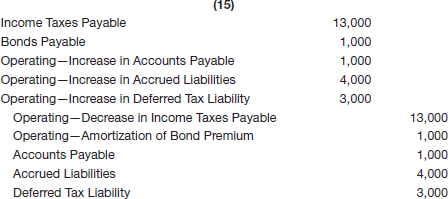
Share Capital–Ordinary and Related Accounts
Comparison of the Share Capital—Ordinary and the Share Premium—Ordinary balances shows that transactions during the year affected these accounts. First, Satellite issues a share dividend of 2 percent to shareholders. As the discussion of worksheet entry (2) indicated, no cash was provided or used by the share dividend transaction. In addition to the shares issued via the share dividend, Satellite sold ordinary shares at HK$16 per share. The company records this transaction as follows.



Also, the company purchased its ordinary shares in the amount of HK$17,000. It records this transaction on the worksheet as follows.
![]()
Final Reconciling Entry
The final entry to reconcile the change in cash and to balance the worksheet is shown below. The HK$7,000 amount is the difference between the beginning and ending cash balance.
![]()
Once the company has determined that the differences between the beginning and ending balances per the worksheet columns have been accounted for, it can total the reconciling transactions columns, and they should balance. Satellite can prepare the statement of cash flows entirely from the items and amounts that appear at the bottom of the worksheet under “Statement of Cash Flows Effects,” as shown in Illustration 23-41.
ILLUSTRATION 23-41
Completed Worksheet for Preparation of Statement of Cash Flows, Satellite Corporation
Preparation of Final Statement
Illustration 23-42 presents a formal statement of cash flows prepared from the data compiled in the lower portion of the worksheet.
ILLUSTRATION 23-42
Statement of Cash Flows, Satellite Corporation
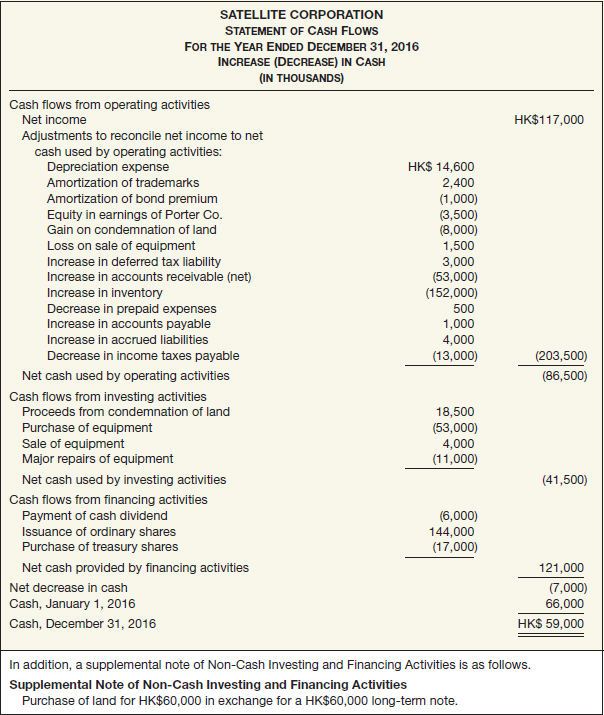
STATEMENT OF CASH FLOWS
As in IFRS, the statement of cash flows is a required statement for U.S. GAAP. In addition, the content and presentation of a U.S. statement of cash flows is similar to one used for IFRS. However, the disclosure requirements related to the statement of cash flows are more extensive under U.S. GAAP.
Relevant Facts
Following are the key similarities and differences between U.S. GAAP and IFRS related to the statement of cash flows.
Similarities
- Both U.S. GAAP and IFRS require that companies prepare a statement of cash flows.
- Both U.S. GAAP and IFRS require that the statement of cash flows should have three major sections—operating, investing, and financing—along with changes in cash and cash equivalents.
- Similar to U.S. GAAP, the cash flow statement can be prepared using either the indirect or direct method under IFRS. For both U.S. GAAP and IFRS, most companies use the indirect method for reporting net cash flow from operating activities.
- The definition of cash equivalents used in U.S. GAAP is similar to that used in IFRS.
Differences
- Under U.S. GAAP, bank overdrafts are classified as financing activities. A major difference in the definition of cash and cash equivalents is that in certain situations, bank overdrafts are considered part of cash and cash equivalents under IFRS.
- Under U.S. GAAP, companies may present non-cash investing and financing activities in the cash flow statement. IFRS requires that non-cash investing and financing activities be excluded from the statement of cash flows. As indicated in the chapter, these non-cash activities should be reported elsewhere. This requirement is interpreted to mean that non-cash investing and financing activities should be disclosed in the notes to the financial statements instead of in the financial statements.
- One area where there can be substantive differences between U.S. GAAP and IFRS relates to the classification of interest, dividends, and taxes. U.S. GAAP requires that except for dividends paid (which are classified as a financing activity), these items are all reported as operating activities. IFRS provides more alternatives for disclosing these items.
About the Numbers
One area where there can be substantive differences between U.S. GAAP and IFRS relates to the classification of interest, dividends, and taxes. The following table indicates the differences between the two approaches.

As indicated, the major difference is that IFRS provides more alternatives for disclosing certain items.
On the Horizon
Presently, the IASB and the FASB are involved in a joint project on the presentation and organization of information in the financial statements. With respect to the cash flow statement specifically, the notion of cash equivalents will probably not be retained. The definition of cash in the existing literature would be retained, and the statement of cash flows would present information on changes in cash only. In addition, the IASB and FASB favor presentation of operating cash flows using the direct method only.
KEY TERMS
cash equivalents, 1184
direct method, 1198
financing activities, 1183
indirect method, 1188
investing activities, 1183
operating activities, 1183
significant non-cash transactions, 1209
statement of cash flows, 1182
SUMMARY OF LEARNING OBJECTIVES
![]() Describe the purpose of the statement of cash flows. The primary purpose of the statement of cash flows is to provide information about cash receipts and cash payments of an entity during a period. A secondary objective is to report the entity's operating, investing, and financing activities during the period.
Describe the purpose of the statement of cash flows. The primary purpose of the statement of cash flows is to provide information about cash receipts and cash payments of an entity during a period. A secondary objective is to report the entity's operating, investing, and financing activities during the period.
![]() Identify the major classifications of cash flows. Companies classify cash flows as follows. (1) Operating activities—transactions that result in the revenues, expenses, gains, and losses that determine net income. (2) Investing activities—lending money and collecting on those loans, and acquiring and disposing of investments, plant assets, and intangible assets. (3) Financing activities—obtaining cash from creditors and repaying loans, issuing and reacquiring share capital, and paying cash dividends.
Identify the major classifications of cash flows. Companies classify cash flows as follows. (1) Operating activities—transactions that result in the revenues, expenses, gains, and losses that determine net income. (2) Investing activities—lending money and collecting on those loans, and acquiring and disposing of investments, plant assets, and intangible assets. (3) Financing activities—obtaining cash from creditors and repaying loans, issuing and reacquiring share capital, and paying cash dividends.
![]() Prepare a statement of cash flows. Preparing the statement involves three major steps. (1) Determine the change in cash. This is the difference between the beginning and the ending cash balance shown on the comparative statements of financial position. (2) Determine the net cash flow from operating activities. This procedure is complex; it involves analyzing not only the current year's income statement but also the comparative statements of financial position and the selected transaction data. (3) Determine cash flows from investing and financing activities. Analyze all other changes in the statement of financial position accounts to determine the effects on cash.
Prepare a statement of cash flows. Preparing the statement involves three major steps. (1) Determine the change in cash. This is the difference between the beginning and the ending cash balance shown on the comparative statements of financial position. (2) Determine the net cash flow from operating activities. This procedure is complex; it involves analyzing not only the current year's income statement but also the comparative statements of financial position and the selected transaction data. (3) Determine cash flows from investing and financing activities. Analyze all other changes in the statement of financial position accounts to determine the effects on cash.
![]() Differentiate between net income and net cash flow from operating activities. Companies must adjust net income on an accrual basis to determine net cash flow from operating activities because some expenses and losses do not cause cash outflows, and some revenues and gains do not provide cash inflows.
Differentiate between net income and net cash flow from operating activities. Companies must adjust net income on an accrual basis to determine net cash flow from operating activities because some expenses and losses do not cause cash outflows, and some revenues and gains do not provide cash inflows.
![]() Determine net cash flows from investing and financing activities. Once a company has computed the net cash flow from operating activities, the next step is to determine whether any other changes in statement of financial position accounts caused an increase or decrease in cash. Net cash flows from investing and financing activities can be determined by examining the changes in non-current statement of financial position accounts.
Determine net cash flows from investing and financing activities. Once a company has computed the net cash flow from operating activities, the next step is to determine whether any other changes in statement of financial position accounts caused an increase or decrease in cash. Net cash flows from investing and financing activities can be determined by examining the changes in non-current statement of financial position accounts.
![]() Identify sources of information for a statement of cash flows. The information to prepare the statement usually comes from three sources. (1) Comparative statements of financial position. Information in these statements indicates the amount of the changes in assets, liabilities, and equities during the period. (2) Current income statement. Information in this statement is used in determining the cash provided by operations during the period. (3) Selected transaction data. These data from the general ledger provide additional detailed information needed to determine how cash was provided or used during the period.
Identify sources of information for a statement of cash flows. The information to prepare the statement usually comes from three sources. (1) Comparative statements of financial position. Information in these statements indicates the amount of the changes in assets, liabilities, and equities during the period. (2) Current income statement. Information in this statement is used in determining the cash provided by operations during the period. (3) Selected transaction data. These data from the general ledger provide additional detailed information needed to determine how cash was provided or used during the period.
![]() Contrast the direct and indirect methods of calculating net cash flow from operating activities. Under the direct approach, companies calculate the major classes of operating cash receipts and cash disbursements. Presentation of the direct approach of reporting net cash flow from operating activities takes the form of a condensed cash-basis income statement. The indirect method adds back to net income the non-cash expenses and losses and subtracts the non-cash revenues and gains.
Contrast the direct and indirect methods of calculating net cash flow from operating activities. Under the direct approach, companies calculate the major classes of operating cash receipts and cash disbursements. Presentation of the direct approach of reporting net cash flow from operating activities takes the form of a condensed cash-basis income statement. The indirect method adds back to net income the non-cash expenses and losses and subtracts the non-cash revenues and gains.
![]() Discuss special problems in preparing a statement of cash flows. These special problems are (1) adjustments to net income, (2) accounts receivable (net), (3) other working capital changes, (4) net loss, and (5) disclosures.
Discuss special problems in preparing a statement of cash flows. These special problems are (1) adjustments to net income, (2) accounts receivable (net), (3) other working capital changes, (4) net loss, and (5) disclosures.
![]() Explain the use of a worksheet in preparing a statement of cash flows. When numerous adjustments are necessary or other complicating factors are present, companies often use a worksheet to assemble and classify the data that will appear on the statement of cash flows. The worksheet is merely a device that aids in the preparation of the statement. Its use is optional.
Explain the use of a worksheet in preparing a statement of cash flows. When numerous adjustments are necessary or other complicating factors are present, companies often use a worksheet to assemble and classify the data that will appear on the statement of cash flows. The worksheet is merely a device that aids in the preparation of the statement. Its use is optional.
Authoritative Literature References
[1] International Accounting Standard 7, Statement of Cash Flows (London, U.K.: International Accounting Standards Committee Foundation, 2001).
[2] International Accounting Standard 7, Statement of Cash Flows (London, U.K.: International Accounting Standards Committee Foundation, 2001), paras. 13–17.
[3] International Accounting Standard 7, Statement of Cash Flows (London, U.K.: International Accounting Standards Committee Foundation, 2001), par. 7.
[4] International Accounting Standard 7, Statement of Cash Flows (London, U.K.: International Accounting Standards Committee Foundation, 2001), par. 19.
[5] International Accounting Standard 7, Statement of Cash Flows (London, U.K.: International Accounting Standards Committee Foundation, 2001), par. 36.
[6] International Accounting Standard 7, Statement of Cash Flows (London, U.K.: International Accounting Standards Committee Foundation, 2001), par. 43.
[7] International Accounting Standard 7, Statement of Cash Flows (London, U.K.: International Accounting Standards Committee Foundation, 2001), par. 31.
![]()
- 1. What is the purpose of the statement of cash flows? What information does it provide?
- 2. Of what use is the statement of cash flows?
- 3. Differentiate between investing activities, financing activities, and operating activities.
- 4. What are the major sources of cash (inflows) in a statement of cash flows? What are the major uses (outflows) of cash?
- 5. Identify and explain the major steps involved in preparing the statement of cash flows.
- 6. Identify the following items as (1) operating, (2) investing, or (3) financing activities: purchase of land, payment of dividends, cash sales, and purchase of treasury shares.
- 7. Unlike the other major financial statements, the statement of cash flows is not prepared from the adjusted trial balance. From what sources does the information to prepare this statement come, and what information does each source provide?
- 8. Why is it necessary to convert accrual-based net income to a cash basis when preparing a statement of cash flows?
- 9. Differentiate between the direct method and the indirect method by discussing each method.
- 10. Broussard Company reported net income of $3.5 million in 2015. Depreciation for the year was $520,000, accounts receivable increased $500,000, and accounts payable increased $300,000. Compute net cash flow from operating activities using the indirect method.
- 11. Collinsworth Co. reported sales on an accrual basis of £100,000. If accounts receivable increased £30,000 and the allowance for doubtful accounts increased £9,000 after a write-off of £2,000, compute cash sales.
- 12. Your roommate is puzzled. During the last year, the company in which she is a shareholder reported a net loss of $675,000, yet its cash increased $321,000 during the same period of time. Explain to your roommate how this situation could occur.
- 13. The board of directors of Gifford Corp. declared cash dividends of £260,000 during the current year. If dividends payable was £85,000 at the beginning of the year and £90,000 at the end of the year, how much cash was paid in dividends during the year?
- 14. Explain how the amount of cash payments to suppliers is computed under the direct method.
- 15. The net income for Letterman Company for 2015 was €320,000. During 2015, depreciation on plant assets was €124,000, amortization of patent was €40,000, and the company incurred a loss on sale of plant assets of €21,000. Compute net cash flow from operating activities.
- 16. Each of the following items must be considered in preparing a statement of cash flows for Blackwell Inc. for the year ended December 31 2015, Indicate how each item is to be shown in the statement, if at all.
(a) Plant assets that had cost $18,000 6½ years before and were being depreciated on a straight-line basis over 10 years with no estimated residual value were sold for $4,000.
(b) During the year, 10,000 ordinary shares with a stated value of $20 a share were issued for $41 a share.
(c) Uncollectible accounts receivable in the amount of $22,000 were written off against Allowance for Doubtful Accounts.
(d) The company sustained a net loss for the year of $50,000. Depreciation amounted to $22,000, and a gain of $9,000 was realized on the sale of non-trading equity investments for $38,000 cash.
- 17. Classify the following items as (1) operating, (2) investing, (3) financing, or (4) significant non-cash investing and financing activities, using the direct method.
(a) Cash payments to employees.
(b) Redemption of bonds payable.
(c) Sale of building at book value.
(d) Cash payments to suppliers.
(e) Exchange of equipment for furniture.
(f) Issuance of preference shares.
(g) Cash received from customers.
(h) Purchase of treasury shares.
(i) Issuance of bonds for land.
(j) Payment of dividends.
(k) Purchase of equipment.
(l) Cash payments for operating expenses.
- 18. Silva Rojas and Hans Jensen were discussing the statement of cash flows of Liu Co. In the notes to the statement of cash flows was a schedule entitled “Non-cash investing and financing activities.” Give three examples of significant non-cash transactions that would be reported in this schedule.
- 19. During 2015, Simms Company redeemed ¥2,000,000 of bonds payable for ¥1,880,000 cash. Indicate how this transaction would be reported on a statement of cash flows, if at all.
- 20. What are some of the arguments in favor of using the indirect (reconciliation) method as opposed to the direct method for reporting a statement of cash flows?
- 21. Why is it desirable to use a worksheet when preparing a statement of cash flows? Is a worksheet required to prepare a statement of cash flows?
- 22. Briefly describe some of the similarities and differences between IFRS and U.S. GAAP with respect to cash flow reporting.

- 23. Explain how the accounting for interest received and paid in a statement of cash flows may differ between IFRS and U.S. GAAP.

- 24. What are some of the key obstacles for the IASB and FASB in their convergence project for the statement of cash flows?

![]()
![]() BE23-1 Wainwright Corporation had the following activities in 2015.
BE23-1 Wainwright Corporation had the following activities in 2015.
1. Sale of land $180,000.
2. Purchase of inventory $845,000.
3. Purchase of treasury shares $72,000.
4. Purchase of equipment $415,000.
5. Issuance of ordinary shares $320,000.
6. Purchase of investments—equity $59,000.
Compute the amount Wainwright should report as net cash provided (used) by investing activities in its statement of cash flows.
![]() BE23-2 Stansfield Corporation had the following activities in 2015.
BE23-2 Stansfield Corporation had the following activities in 2015.
1. Payment of accounts payable €770,000.
2. Issuance of ordinary shares €250,000.
3. Payment of dividends €350,000.
4. Collection of note receivable €100,000.
5. Issuance of bonds payable €510,000.
6. Purchase of treasury shares €46,000.
Compute the amount Stansfield should report as net cash provided (used) by financing activities in its 2015 statement of cash flows.
![]() BE23-3 Novak Corporation is preparing its 2015 statement of cash flows, using the indirect method. The following is a list of items that may affect the statement. Using the code letters provided, indicate how each item will affect Novak's 2015 statement of cash flows.
BE23-3 Novak Corporation is preparing its 2015 statement of cash flows, using the indirect method. The following is a list of items that may affect the statement. Using the code letters provided, indicate how each item will affect Novak's 2015 statement of cash flows.

- ___(a) Purchase of land and building.
- ___(b) Decrease in accounts receivable.
- ___(c) Issuance of shares.
- ___(d) Depreciation expense.
- ___(e) Sale of land at book value.
- ___(f) Sale of land at a gain.
- ___(g) Payment of dividends.
- ___(h) Increase in accounts receivable.
- ___(i) Purchase of an equity investment.
- ___(j) Increase in accounts payable.
- ___(k) Decrease in accounts payable.
- ___(l) Loan from bank by signing note.
- ___(m) Purchase of equipment using a note.
- ___(n) Increase in inventory.
- ___(o) Issuance of bonds.
- ___(p) Retirement of bonds payable.
- ___(q) Sale of equipment at a loss.
- ___(r) Purchase of treasury shares.
![]() BE23-4 Bloom Corporation had the following 2015 income statement.
BE23-4 Bloom Corporation had the following 2015 income statement.

The following accounts increased during 2015: accounts receivable €12,000, inventory €11,000, and accounts payable €13,000. Prepare the cash flows from operating activities section of Bloom's 2015 statement of cash flows using the direct method.
![]() BE23-5 Use the information from BE23-4 for Bloom Corporation. Prepare the cash flows from operating activities section of Bloom's 2015 statement of cash flows using the indirect method.
BE23-5 Use the information from BE23-4 for Bloom Corporation. Prepare the cash flows from operating activities section of Bloom's 2015 statement of cash flows using the indirect method.
![]() BE23-6 At January 1, 2015, Eikenberry Inc. had accounts receivable of $72,000. At December 31, 2015, accounts receivable is $54,000. Sales for 2015 total $420,000. Compute Eikenberry's 2015 cash receipts from customers.
BE23-6 At January 1, 2015, Eikenberry Inc. had accounts receivable of $72,000. At December 31, 2015, accounts receivable is $54,000. Sales for 2015 total $420,000. Compute Eikenberry's 2015 cash receipts from customers.
![]() BE23-7 Moxley Corporation had January 1 and December 31 balances as follows.
BE23-7 Moxley Corporation had January 1 and December 31 balances as follows.
![]()
For 2015, cost of goods sold was €500,000. Compute Moxley's 2015 cash payments to suppliers.
![]() BE23-8 In 2015, Elbert Corporation had net cash provided by operating activities of £531,000, net cash used by investing activities of £963,000, and net cash provided by financing activities of £585,000. At January 1, 2015, the cash balance was £333,000. Compute December 31, 2015, cash.
BE23-8 In 2015, Elbert Corporation had net cash provided by operating activities of £531,000, net cash used by investing activities of £963,000, and net cash provided by financing activities of £585,000. At January 1, 2015, the cash balance was £333,000. Compute December 31, 2015, cash.
![]() BE23-9 Loveless Corporation had the following 2015 income statement.
BE23-9 Loveless Corporation had the following 2015 income statement.

In 2015, Loveless had the following activity in selected accounts.

Prepare Loveless's cash flows from operating activities section of the statement of cash flows using (a) the direct method and (b) the indirect method.
![]() BE23-10 Hendrickson Corporation reported net income of $50,000 in 2015. Depreciation expense was $17,000. The following working capital accounts changed.
BE23-10 Hendrickson Corporation reported net income of $50,000 in 2015. Depreciation expense was $17,000. The following working capital accounts changed.

Compute net cash provided by operating activities.
![]() BE23-11 In 2015, Shaw Corporation reported a net loss of €70,000. Shaw's only net income adjustments were depreciation expense €81,000, and increase in accounts receivable €8,100. Compute Shaw's net cash provided (used) by operating activities.
BE23-11 In 2015, Shaw Corporation reported a net loss of €70,000. Shaw's only net income adjustments were depreciation expense €81,000, and increase in accounts receivable €8,100. Compute Shaw's net cash provided (used) by operating activities.
![]() BE23-12 In 2015, Leppard Inc. issued 1,000 ordinary shares of $10 par value for land worth $40,000.
BE23-12 In 2015, Leppard Inc. issued 1,000 ordinary shares of $10 par value for land worth $40,000.
(a) Prepare Leppard's journal entry to record the transaction.
(b) Indicate the effect the transaction has on cash.
(c) Indicate how the transaction is reported on the statement of cash flows.
![]() BE23-13 Indicate in general journal form how the items below would be entered in a worksheet for the preparation of the statement of cash flows.
BE23-13 Indicate in general journal form how the items below would be entered in a worksheet for the preparation of the statement of cash flows.
(a) Net income is ¥317,000,000.
(b) Cash dividends declared and paid totaled ¥120,000,000.
(c) Equipment was purchased for ¥114,000,000.
(d) Equipment that originally cost ¥40,000,000 and had accumulated depreciation of ¥32,000,000 was sold for ¥10,000,000.
![]()
![]() E23-1 (Classification of Transactions) Springsteen Co. had the following activity in its most recent year of operations.
E23-1 (Classification of Transactions) Springsteen Co. had the following activity in its most recent year of operations.
(a) Pension expense exceeds amount funded.
(b) Redemption of bonds payable.
(c) Sale of building at book value.
(d) Depreciation.
(e) Exchange of equipment for furniture.
(f) Issuance of ordinary shares.
(g) Amortization of intangible assets.
(h) Purchase of treasury shares.
(i) Issuance of bonds for land.
(j) Payment of dividends.
(k) Increase in interest receivable on notes receivable.
(l) Purchase of equipment.
Instructions
Classify the items as (1) operating—add to net income, (2) operating—deduct from net income, (3) investing, (4) financing, or (5) significant non-cash investing and financing activities. Use the indirect method.
![]() E23-2 (Statement Presentation of Transactions—Indirect Method) Each of the following items must be considered in preparing a statement of cash flows (indirect method) for Granderson Inc. for the year ended December 31, 2015.
E23-2 (Statement Presentation of Transactions—Indirect Method) Each of the following items must be considered in preparing a statement of cash flows (indirect method) for Granderson Inc. for the year ended December 31, 2015.
(a) Plant assets that had cost €25,000 6 years before and were being depreciated on a straight-line basis over 10 years with no estimated residual value were sold at the beginning of the year for €5,300.
(b) During the year, 10,000 ordinary shares with a stated value of €10 a share were issued for €33 a share.
(c) Uncollectible accounts receivable in the amount of €27,000 were written off against Allowance for Doubtful Accounts.
(d) The company sustained a net loss for the year of €50,000. Depreciation amounted to €22,000, and a gain of €9,000 was realized on the sale of land for €39,000 cash.
(e) A 3-month certificate of deposit was purchased for €100,000. The company uses a cash and cash-equivalent basis for its cash flow statement.
(f) Patent amortization for the year was €20,000.
(g) The company exchanged ordinary shares for a 70% interest in Plumlee Co. for €900,000.
(h) During the year, treasury shares costing €47,000 were purchased.
(i) The company recognized an unrealized holding gain on a debt investment not held for collection.
Instructions
State where each item is to be shown in the statement of cash flows, if at all.
![]() E23-3 (Preparation of Operating Activities Section—Indirect Method, Periodic Inventory) The income statement of Rodriquez Company is shown below.
E23-3 (Preparation of Operating Activities Section—Indirect Method, Periodic Inventory) The income statement of Rodriquez Company is shown below.

Additional information:
- 1. Accounts receivable decreased R$310,000 during the year.
- 2. Prepaid expenses increased R$170,000 during the year.
- 3. Accounts payable to suppliers of merchandise decreased R$275,000 during the year.
- 4. Accrued expenses payable decreased R$120,000 during the year.
- 5. Administrative expenses include depreciation expense of R$60,000.
Instructions
Prepare the operating activities section of the statement of cash flows for the year ended December 31, 2015, for Rodriquez Company, using the indirect method.
![]() E23-4 (Preparation of Operating Activities Section—Direct Method) Data for the Rodriquez Company are presented in E23-3.
E23-4 (Preparation of Operating Activities Section—Direct Method) Data for the Rodriquez Company are presented in E23-3.
![]() E23-5 (Preparation of Operating Activities Section—Direct Method) Norman Company's income statement for the year ended December 31, 2015, contained the following condensed information.
E23-5 (Preparation of Operating Activities Section—Direct Method) Norman Company's income statement for the year ended December 31, 2015, contained the following condensed information.

![]() E23-6 (Preparation of Operating Activities Section—Indirect Method) Data for Norman Company are presented in E23-5.
E23-6 (Preparation of Operating Activities Section—Indirect Method) Data for Norman Company are presented in E23-5.
![]() E23-7 (Computation of Operating Activities—Direct Method) Presented below are two independent situations.
E23-7 (Computation of Operating Activities—Direct Method) Presented below are two independent situations.
Situation A: Chenowith Co. reports revenues of €200,000 and operating expenses of €110,000 in its first year of operations, 2015. Accounts receivable and accounts payable at year-end were €71,000 and €39,000, respectively. Assume that the accounts payable related to operating expenses. (Ignore income taxes.)
Instructions
Using the direct method, compute net cash provided (used) by operating activities.
Situation B: The income statement for Edgebrook Company shows cost of goods sold €310,000 and operating expenses (exclusive of depreciation) €230,000. The comparative statements of financial position for the year show that inventory increased €21,000, prepaid expenses decreased €8,000, accounts payable (related to merchandise) decreased €17,000, and accrued expenses payable increased €11,000.
Instructions
Compute (a) cash payments to suppliers and (b) cash payments for operating expenses.
![]() E23-8 (Schedule of Net Cash Flow from Operating Activities—Indirect Method) Messner Co. reported €145,000 of net income for 2015. The accountant, in preparing the statement of cash flows, noted several items occurring during 2015 that might affect cash flows from operating activities. These items are listed below.
E23-8 (Schedule of Net Cash Flow from Operating Activities—Indirect Method) Messner Co. reported €145,000 of net income for 2015. The accountant, in preparing the statement of cash flows, noted several items occurring during 2015 that might affect cash flows from operating activities. These items are listed below.
- Messner purchased 100 treasury shares at a cost of €20 per share. These shares were then resold at €25 per share.
- Messner sold 100 ordinary shares of Nokia at €200 per share. The acquisition cost of these shares was €165 per share. This investment was shown on Messner's December 31, 2014, statement of financial position as a non-trading equity investment.
- Messner revised its estimate for bad debts. Before 2015, Messner's bad debt expense was 1% of its net sales. In 2015, this percentage was increased to 2%. Net sales for 2015 were €500,000, and net accounts receivable decreased by €12,000 during 2015.
- Messner issued 500 ordinary shares with a €10 par value for a patent. The fair value of the shares on the date of the transaction was €23 per share.
- Depreciation expense is €39,000.
- Messner Co. holds 30% of the Sanchez Company's ordinary shares as a long-term investment. Sanchez Company reported €27,000 of net income for 2015.
- Sanchez Company paid a total of €2,000 of cash dividends to all investees in 2015.
- Messner declared a 10% share dividend. One thousand ordinary shares with a €10 par value were distributed. The market price at date of issuance was €20 per share.
Instructions
Prepare a schedule that shows the net cash flow from operating activities using the indirect method. Assume no items other than those listed above affected the computation of 2015 net cash flow from operating activities.
![]() E23-9 (SCF—Direct Method) Costa Corp. uses the direct method to prepare its statement of cash flows. Costa's trial balances at December 31, 2015 and 2014, are as follows.
E23-9 (SCF—Direct Method) Costa Corp. uses the direct method to prepare its statement of cash flows. Costa's trial balances at December 31, 2015 and 2014, are as follows.
Additional information:
- Costa purchased R$5,000 in equipment during 2015.
- Costa allocated one-third of its depreciation expense to selling expenses and the remainder to general and administrative expenses.
- Bad debt expense for 2015 was R$5,000, and write-offs of uncollectible accounts totaled R$3,800.
- Interest expense includes R$500 of discount amortization.
Instructions
Determine what amounts Costa should report in its statement of cash flows for the year ended December 31, 2015, for the following items.
(a) Cash collected from customers.
(b) Cash paid to suppliers.
(c) Cash paid for interest.
(d) Cash paid for income taxes.
(e) Cash paid for selling expenses.
![]() E23-10 (Classification of Transactions) Following are selected statement of financial position accounts of Sander Bros. Corp. at December 31, 2015 and 2014, and the increases or decreases in each account from 2014 to 2015. Also presented is selected income statement information for the year ended December 31, 2015, and additional information.
E23-10 (Classification of Transactions) Following are selected statement of financial position accounts of Sander Bros. Corp. at December 31, 2015 and 2014, and the increases or decreases in each account from 2014 to 2015. Also presented is selected income statement information for the year ended December 31, 2015, and additional information.
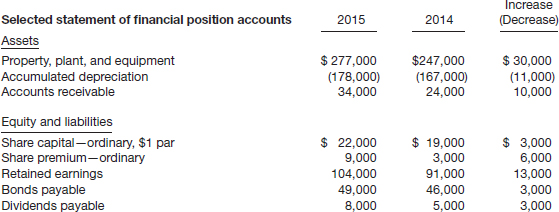
Additional information:
- During 2015, equipment costing $45,000 was sold for cash.
- Accounts receivable relate to sales of merchandise.
- During 2015, $25,000 of bonds payable were issued in exchange for property, plant, and equipment. There was no amortization of bond discount or premium.
Instructions
Determine the category (operating, investing, or financing) and the amount that should be reported in the statement of cash flows for the following items.
(a) Payments for purchase of property, plant, and equipment.
(b) Proceeds from the sale of equipment.
(c) Cash dividends paid.
(d) Redemption of bonds payable.
![]() E23-11 (SCF—Indirect Method) Condensed financial data of Fairchild Company for 2015 and 2014 are presented below.
E23-11 (SCF—Indirect Method) Condensed financial data of Fairchild Company for 2015 and 2014 are presented below.
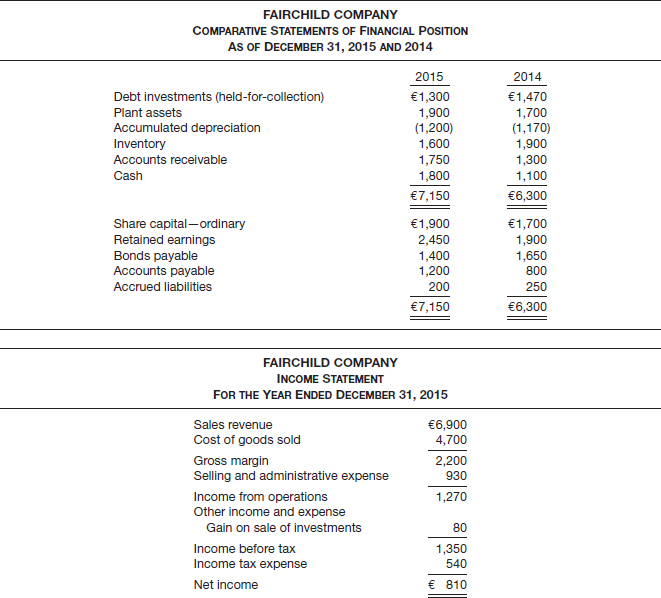
![]() E23-12 (SCF—Direct Method) Data for Fairchild Company are presented in E23-11.
E23-12 (SCF—Direct Method) Data for Fairchild Company are presented in E23-11.
![]() E23-13 (SCF—Direct Method) Andrews Inc., a greeting card company, had the following statements prepared as of December 31, 2015.
E23-13 (SCF—Direct Method) Andrews Inc., a greeting card company, had the following statements prepared as of December 31, 2015.
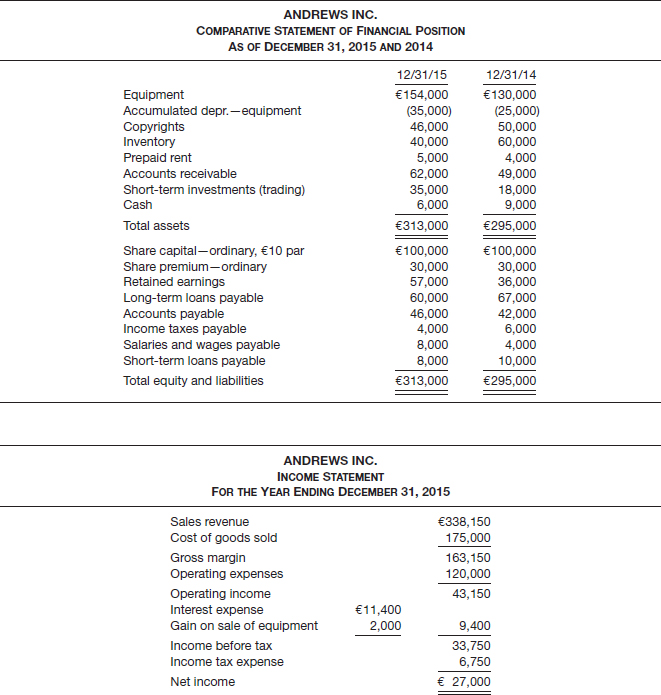
Additional information:
- Dividends in the amount of €6,000 were declared and paid during 2015.
- Depreciation expense and amortization expense are included in operating expenses.
- No unrealized gains or losses have occurred on the investments during the year.
- Equipment that had a cost of €30,000 and was 70% depreciated was sold during 2015.
Instructions
Prepare a statement of cash flows using the direct method.
![]() E23-14 (SCF—Indirect Method) Data for Andrews Inc. are presented in E23-13.
E23-14 (SCF—Indirect Method) Data for Andrews Inc. are presented in E23-13.
![]() E23-15 (SCF—Indirect Method) The following are data taken from the records of Durand Company.
E23-15 (SCF—Indirect Method) The following are data taken from the records of Durand Company.
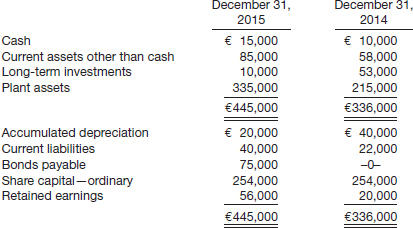
Additional information:
- Held-for-collection investments carried at a cost of €43,000 on December 31, 2014, were sold in 2015 for €34,000. The loss was incorrectly charged directly to Retained Earnings.
- Plant assets that cost €60,000 and were 80% depreciated were sold during 2015 for €8,000. The loss was incorrectly charged directly to Retained Earnings.
- Net income as reported on the income statement for the year was €59,000.
- Dividends paid amounted to €10,000.
- Depreciation charged for the year was €28,000.
Instructions
Prepare a statement of cash flows for the year 2015 using the indirect method.
![]() E23-16 (Cash Provided by Operating, Investing, and Financing Activities) The statement of financial position data of Yang Company at the end of 2015 and 2014 follow (amounts in thousands).
E23-16 (Cash Provided by Operating, Investing, and Financing Activities) The statement of financial position data of Yang Company at the end of 2015 and 2014 follow (amounts in thousands).

Land was acquired for ¥30,000 in exchange for ordinary shares, par ¥30,000, during the year; all equipment purchased was for cash. Equipment costing ¥13,000 was sold for ¥3,000; book value of the equipment was ¥6,000. Cash dividends of ¥9,000 were declared and paid during the year.
Instructions
Compute net cash provided (used) by:
(a) Operating activities (indirect).
(b) Investing activities.
(c) Financing activities.
![]() E23-17 (SCF—Indirect Method and Statement of Financial Position) Ochoa Inc., had the following condensed statement of financial position at the end of operations for 2014 (¥ in thousands).
E23-17 (SCF—Indirect Method and Statement of Financial Position) Ochoa Inc., had the following condensed statement of financial position at the end of operations for 2014 (¥ in thousands).

During 2015, the following occurred.
- A tract of land was purchased for ¥11,000.
- Bonds payable in the amount of ¥20,000 were retired at par.
- An additional ¥10,000 in ordinary shares were issued at par.
- Dividends totaling ¥9,375 were paid to shareholders.
- Net income was ¥30,250 after deducting depreciation of ¥13,500.
- Land was purchased through the issuance of ¥22,500 in bonds.
- Ochoa Inc. sold part of its investment portfolio for ¥12,875. This transaction resulted in a gain of ¥2,000 for the company. The company classifies them as non-trading equity investments.
- Both current assets (other than cash) and current liabilities remained at the same amount.
Instructions
(a) Prepare a statement of cash flows for 2015 using the indirect method.
(b) Prepare the condensed statement of financial position for Ochoa Inc. as it would appear at December 31, 2015.
![]() E23-18 (Partial SCF—Indirect Method) The accounts below appear in the ledger of Popovich Company.
E23-18 (Partial SCF—Indirect Method) The accounts below appear in the ledger of Popovich Company.
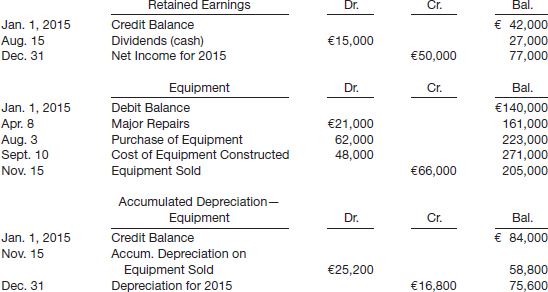
Instructions
From the postings in the accounts above, indicate how the information is reported on a statement of cash flows by preparing a partial statement of cash flows using the indirect method. The loss on sale of equipment (November 15) was €5,800.
![]() E23-19 (Worksheet Analysis of Selected Accounts) Data for Popovich Company are presented in E23-18.
E23-19 (Worksheet Analysis of Selected Accounts) Data for Popovich Company are presented in E23-18.
Instructions
Prepare entries in journal form for all adjustments that should be made on a worksheet for a statement of cash flows.
![]() E23-20 (Worksheet Analysis of Selected Transactions) The transactions below took place during the year 2015.
E23-20 (Worksheet Analysis of Selected Transactions) The transactions below took place during the year 2015.
- Convertible bonds payable with a par value of $300,000 were exchanged for unissued ordinary shares with a par value of $300,000. The market price of both types of securities was par.
- The net income for the year was $360,000.
- Depreciation expense for the building was $90,000.
- Some old equipment was traded in on the purchase of some newer equipment and the following entry was made. (The exchange has commercial substance.)

The Gain on Disposal of Plant Assets was credited to current operations as ordinary income.
- Dividends in the amount of $123,000 were declared. They are payable in January of next year.
Instructions
Show by journal entries the adjustments that would be made on a worksheet for a statement of cash flows.
![]() E23-21 (Worksheet Preparation) Below are the comparative statements of financial position for Lowenstein Corporation.
E23-21 (Worksheet Preparation) Below are the comparative statements of financial position for Lowenstein Corporation.
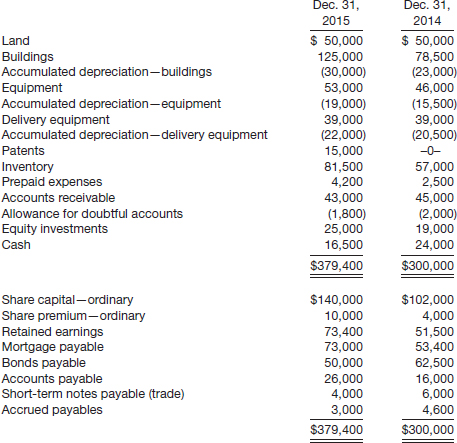
Dividends in the amount of $10,000 were declared and paid in 2015.
Instructions
From this information, prepare a worksheet for a statement of cash flows. Make reasonable assumptions as appropriate. The equity investments are considered trading, and no unrealized gains or losses have occurred on these securities.
![]() P23-1 (SCF—Indirect Method) The following is Sullivan Corp.'s comparative statement of financial position accounts at December 31, 2015 and 2014, with a column showing the increase (decrease) from 2014 to 2015.
P23-1 (SCF—Indirect Method) The following is Sullivan Corp.'s comparative statement of financial position accounts at December 31, 2015 and 2014, with a column showing the increase (decrease) from 2014 to 2015.
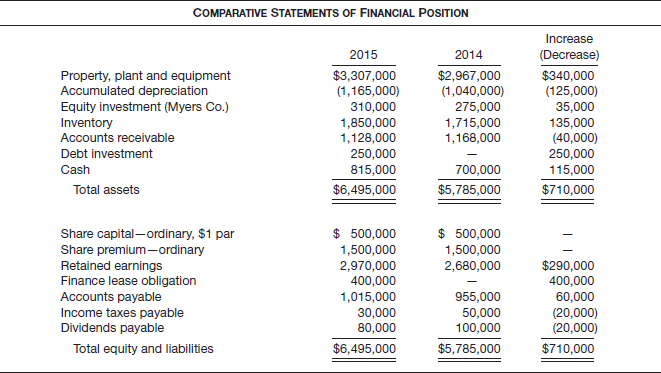
Additional information:
- On December 31, 2013, Sullivan acquired 25% of Myers Co.'s ordinary shares for $275,000. On that date, the carrying value of Myers' assets and liabilities, which approximated their fair values, was $1,100,000. Myers reported income of $140,000 for the year ended December 31, 2015. No dividend was paid on Myers' ordinary shares during the year.
- During 2015, Sullivan loaned $300,000 to TLC Co., an unrelated company. TLC made the first semi-annual principal repayment of $50,000, plus interest at 10%, on December 31, 2015.
- On January 2, 2015, Sullivan sold equipment costing $60,000, with a carrying amount of $38,000, for $40,000 cash.
- On December 31, 2015, Sullivan entered into a finance lease for an office building. The present value of the annual rental payments is $400,000, which equals the fair value of the building. Sullivan made the first rental payment of $60,000 when due on January 2, 2016.
- Net income for 2015 was $370,000.
- Sullivan declared and paid cash dividends for 2015 and 2014 as shown below.

Instructions
Prepare a statement of cash flows for Sullivan Corp. for the year ended December 31, 2015, using the indirect method.
![]()
![]() P23-2 (SCF—Indirect Method) The comparative statements of financial position for Hinckley Corporation include the information shown on page 1236.
P23-2 (SCF—Indirect Method) The comparative statements of financial position for Hinckley Corporation include the information shown on page 1236.
Additional data related to 2015 are as follows.
- Equipment that had cost €11,000 and was 40% depreciated at time of disposal was sold for €2,500.
- €10,000 of the long-term note payable was paid by issuing ordinary shares.
- Cash dividends paid were €5,000.
- On January 1, 2015, the building was completely destroyed by a flood. Insurance proceeds on the building were €32,000.
- Equity investments were sold at €1,700 above their cost.
- Cash was paid for the acquisition of equipment.
- A long-term note for €16,000 was issued for the acquisition of equipment.
- Interest of €2,000 and income taxes of €6,500 were paid in cash.
Instructions
Prepare a statement of cash flows using the indirect method.
![]() P23-3 (SCF—Direct Method) Mortonson Company has not yet prepared a formal statement of cash flows for the 2015 fiscal year. Comparative statements of financial position as of December 31, 2014 and 2015, and a statement of income and retained earnings for the year ended December 31, 2015, are presented as follows.
P23-3 (SCF—Direct Method) Mortonson Company has not yet prepared a formal statement of cash flows for the 2015 fiscal year. Comparative statements of financial position as of December 31, 2014 and 2015, and a statement of income and retained earnings for the year ended December 31, 2015, are presented as follows.
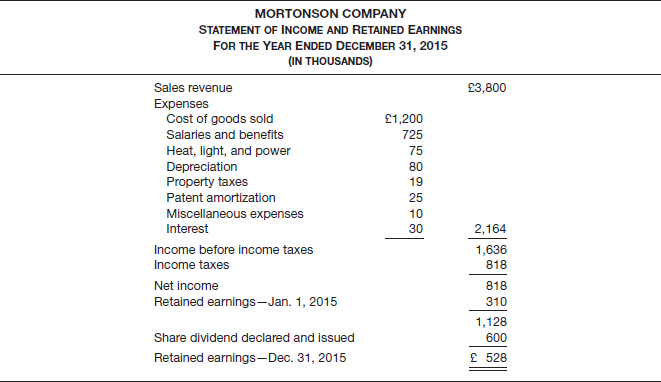
![]() P23-4 (SCF—Direct Method) Michaels Company had available at the end of 2015 the following information.
P23-4 (SCF—Direct Method) Michaels Company had available at the end of 2015 the following information.
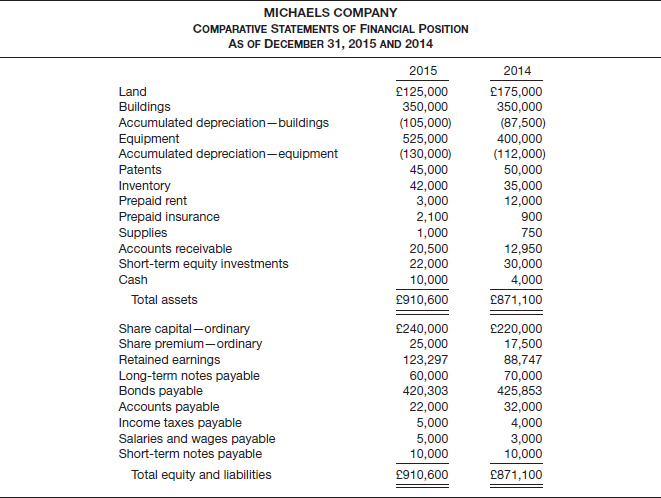
![]() P23-5 (SCF—Indirect Method, and Net Cash Flow from Operating Activities, Direct Method) Comparative statement of financial position accounts of Marcus Inc. are presented below.
P23-5 (SCF—Indirect Method, and Net Cash Flow from Operating Activities, Direct Method) Comparative statement of financial position accounts of Marcus Inc. are presented below.
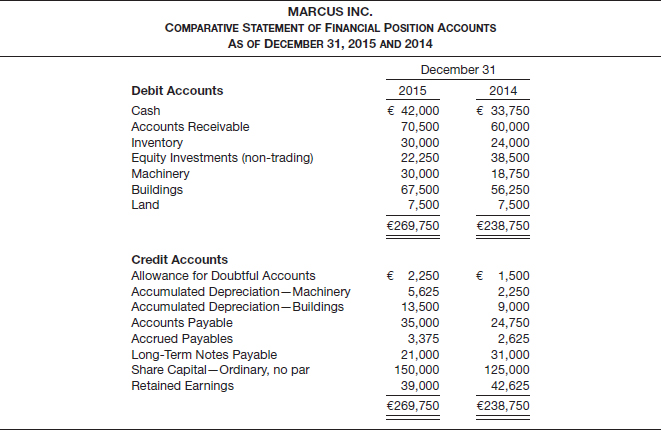
Additional data (ignoring taxes):
- Net income for the year was €42,500.
- Cash dividends declared and paid during the year were €21,125.
- A 20% share dividend was declared during the year. €25,000 of retained earnings was capitalized.
- Equity investments that cost €25,000 were sold during the year for €28,750.
- Machinery that cost €3,750, on which €750 of depreciation had accumulated, was sold for €2,200.
Marcus's 2015 income statement follows (ignoring taxes).

Instructions
(a) Compute net cash flow from operating activities using the direct method.
(b) Prepare a statement of cash flows using the indirect method.
![]()
![]() P23-6 (SCF—Direct and Indirect Methods from Comparative Financial Statements) Chapman Company, a major retailer of bicycles and accessories, operates several stores and is a publicly traded company. The comparative statement of financial position and income statement for Chapman as of May 31, 2015, are as follows. The company is preparing its statement of cash flows.
P23-6 (SCF—Direct and Indirect Methods from Comparative Financial Statements) Chapman Company, a major retailer of bicycles and accessories, operates several stores and is a publicly traded company. The comparative statement of financial position and income statement for Chapman as of May 31, 2015, are as follows. The company is preparing its statement of cash flows.

The following is additional information concerning Chapman's transactions during the year ended May 31, 2015.
- All sales during the year were made on account.
- All merchandise was purchased on account, comprising the total accounts payable account.
- Plant assets costing $98,000 were purchased by paying $28,000 in cash and issuing 7,000 ordinary shares.
- The “other expenses” are related to prepaid items.
- All income taxes incurred during the year were paid during the year.
- In order to supplement its cash, Chapman issued 2,000 ordinary shares at par value.
- There were no penalties assessed for the retirement of bonds.
- Cash dividends of $105,000 were declared and paid at the end of the fiscal year.
Instructions
- (a) Compare and contrast the direct method and the indirect method for reporting cash flows from operating activities.
- (b) Prepare a statement of cash flows for Chapman Company for the year ended May 31, 2015, using the direct method. Be sure to support the statement with appropriate calculations.
- (c) Using the indirect method, calculate only the net cash flow from operating activities for Chapman Company for the year ended May 31, 2015.
![]() P23-7 (SCF—Direct and Indirect Methods) Comparative statement of financial position accounts of Shi Company are presented below.
P23-7 (SCF—Direct and Indirect Methods) Comparative statement of financial position accounts of Shi Company are presented below.
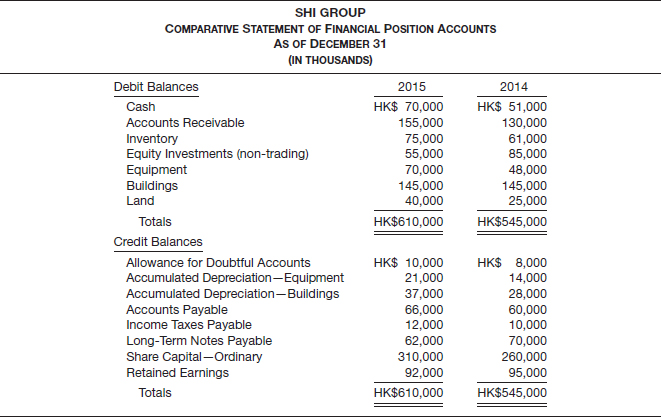
- Equipment that cost HK$10,000 and was 60% depreciated was sold in 2015.
- Cash dividends were declared and paid during the year.
- Ordinary shares were issued in exchange for land.
- Equity investments that cost HK$35,000 were sold during the year.
- There were no write-offs of uncollectible accounts during the year.
Shi's 2015 income statement is as follows.

Instructions
(a) Compute net cash provided by operating activities under the direct method.
(b) Prepare a statement of cash flows using the indirect method.
![]()
![]() P23-8 (Indirect SCF) Greco Corporation has contracted with you to prepare a statement of cash flows. The controller has provided the following trial balance information.
P23-8 (Indirect SCF) Greco Corporation has contracted with you to prepare a statement of cash flows. The controller has provided the following trial balance information.
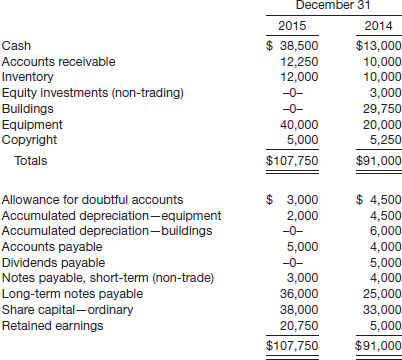
Additional data related to 2015 are as follows.
- Equipment that had cost $11,000 and was 30% depreciated at time of disposal was sold for $2,500.
- $5,000 of the long-term note payable was paid by issuing ordinary shares.
- Cash dividends paid were $5,000.
- On January 1, 2015, the building was completely destroyed by a flood. Insurance proceeds on the building were $33,000 (net of $4,000 taxes).
- Equity investments (non-trading) were sold at $1,500 above their cost. The company has made similar sales and investments in the past.
- Cash and a long-term note for $16,000 were given for the acquisition of equipment.
- Interest of $2,000 and income taxes of $5,000 were paid in cash.
Instructions
- (a) Use the indirect method to analyze the above information and prepare a statement of cash flows for Greco.
- (b) What would you expect to observe in the operating, investing, and financing sections of a statement of cash flows of:
(1) A severely financially troubled firm?
(2) A recently formed firm that is experiencing rapid growth?
![]()
![]() CA23-1 (Analysis of Improper SCF) The following statement was prepared by Maloney Corporation's accountant.
CA23-1 (Analysis of Improper SCF) The following statement was prepared by Maloney Corporation's accountant.
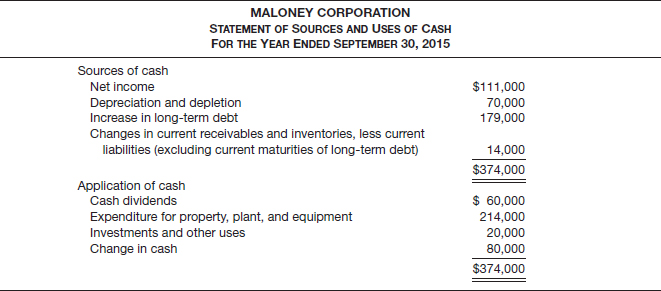
The following additional information relating to Maloney Corporation is available for the year ended September 30, 2015.
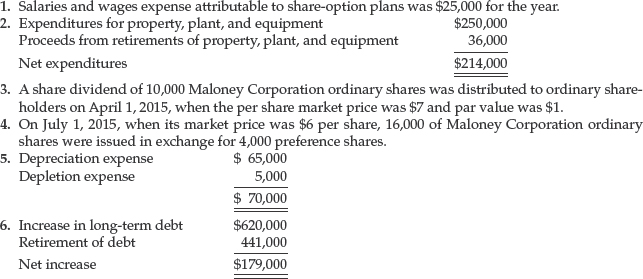
Instructions
- (a) In general, what are the objectives of a statement of the type shown above for Maloney Corporation? Explain.
- (b) Identify the weaknesses in the form and format of Maloney Corporation's statement of cash flows without reference to the additional information. (Assume adoption of the indirect method.)
- (c) For each of the six items of additional information for the statement of cash flows, indicate the preferable treatment and explain why the suggested treatment is preferable.
![]() CA23-2 (SCF Theory and Analysis of Improper SCF) Teresa Ramirez and Lenny Traylor are examining the following statement of cash flows for Panaka Clothing Store's first year of operations.
CA23-2 (SCF Theory and Analysis of Improper SCF) Teresa Ramirez and Lenny Traylor are examining the following statement of cash flows for Panaka Clothing Store's first year of operations.
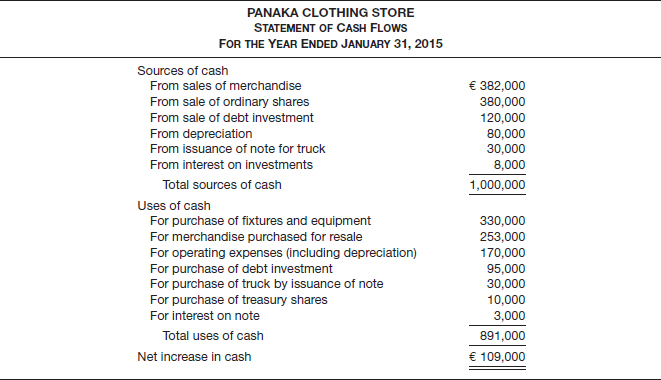
Teresa claims that Panaka's statement of cash flows is an excellent portrayal of a superb first year, with cash increasing €109,000. Lenny replies that it was not a superb first year—that the year was an operating failure, the statement was incorrectly presented, and €109,000 is not the actual increase in cash.
Instructions
- (a) With whom do you agree, Teresa or Lenny? Explain your position.
- (b) Using the data provided, prepare a statement of cash flows in proper indirect method form. The only non-cash items in income are depreciation and the gain from the sale of the investment (purchase and sale are related).
CA23-3 (SCF Theory and Analysis of Transactions) Ashley Company is a young and growing producer of electronic measuring instruments and technical equipment. You have been retained by Ashley to advise it in the preparation of a statement of cash flows using the indirect method. For the fiscal year ended October 31, 2015, you have obtained the following information concerning certain events and transactions of Ashley.
- The amount of reported earnings for the fiscal year was $700,000, which included a deduction for a loss of $110,000 (see item 5 below).
- Depreciation expense of $315,000 was included in the income statement.
- Uncollectible accounts receivable of $40,000 were written off against the allowance for doubtful accounts. Also, $51,000 of bad debt expense was included in determining income for the fiscal year, and the same amount was added to the allowance for doubtful accounts.
- A gain of $6,000 was realized on the sale of a machine. It originally cost $75,000, of which $30,000 was undepreciated on the date of sale.
- On April 1, 2015, lightning caused an uninsured building loss of $110,000 ($180,000 loss, less reduction in income taxes of $70,000). This loss was included in determining income as indicated in item 1 above.
- On July 3, 2015, building and land were purchased for $700,000. Ashley gave in payment $75,000 cash, $200,000 fair value of its unissued ordinary shares, and signed a $425,000 mortgage note payable.
- On August 3, 2015, $800,000 face value of Ashley's 10% convertible preference shares was converted into $150,000 par value of its ordinary shares.
Instructions
Explain whether each of the seven numbered items above is a source or use of cash, and explain how each should be disclosed in Ashley's statement of cash flows for the fiscal year ended October 31, 2015. If any item is neither a source nor a use of cash, explain why it is not, and indicate the disclosure, if any, that should be made of the item for the fiscal year ended October 31, 2015.
![]() CA23-4 (Analysis of Transactions' Effect on SCF) Each of the following items must be considered in preparing a statement of cash flows for Boer Fashions Inc. for the year ended December 31, 2015.
CA23-4 (Analysis of Transactions' Effect on SCF) Each of the following items must be considered in preparing a statement of cash flows for Boer Fashions Inc. for the year ended December 31, 2015.
- Fixed assets that had cost R20,000 6½ years before and were being depreciated on a 10-year basis, with no estimated residual value, were sold for R4,750.
- During the year, goodwill of R15,000 was considered impaired and was completely written off to expense.
- During the year, 500 ordinary shares with a stated value of R25 a share were issued for R32 a share.
- The company sustained a net loss for the year of R2,100. Depreciation amounted to R2,000 and patent amortization was R400.
- Uncollectible accounts receivable in the amount of R2,000 were written off against Allowance for Doubtful Accounts.
- Equity investments (non-trading) that cost R12,000 when purchased 4 years earlier were sold for R10,600.
- Bonds payable with a par value of R24,000 on which there was an unamortized bond premium of R2,000 were redeemed at 101.
Instructions
For each item, state where it is to be shown in the statement and then how you would present the necessary information, including the amount. Consider each item to be independent of the others. Assume that correct entries were made for all transactions as they took place.
CA23-5 (Purpose and Elements of SCF) IFRS requires the statement of cash flows be presented when financial statements are prepared.
Instructions
- (a) Explain the purposes of the statement of cash flows.
- (b) List and describe the three categories of activities that must be reported in the statement of cash flows.
- (c) Identify and describe the two methods that are allowed for reporting cash flows from operations.
- (d) Describe the presentation of non-cash investing and financing transactions. Include in your description an example of a non-cash investing and financing transaction.
 CA23-6 (Cash Flow Reporting) Brockman Guitar Company is in the business of manufacturing top-quality, steel-string folk guitars. In recent years, the company has experienced working capital problems resulting from the procurement of factory equipment, the unanticipated buildup of receivables and inventories, and the payoff of a balloon mortgage on a new manufacturing facility. The founder and president of the company, Barbara Brockman, has attempted to raise cash from various financial institutions, but to no avail because of the company's poor performance in recent years. In particular, the company's lead bank, First Financial, is especially concerned about Brockman's inability to maintain a positive cash position. The commercial loan officer from First Financial told Barbara, “I can't even consider your request for capital financing unless I see that your company is able to generate positive cash flows from operations.”
CA23-6 (Cash Flow Reporting) Brockman Guitar Company is in the business of manufacturing top-quality, steel-string folk guitars. In recent years, the company has experienced working capital problems resulting from the procurement of factory equipment, the unanticipated buildup of receivables and inventories, and the payoff of a balloon mortgage on a new manufacturing facility. The founder and president of the company, Barbara Brockman, has attempted to raise cash from various financial institutions, but to no avail because of the company's poor performance in recent years. In particular, the company's lead bank, First Financial, is especially concerned about Brockman's inability to maintain a positive cash position. The commercial loan officer from First Financial told Barbara, “I can't even consider your request for capital financing unless I see that your company is able to generate positive cash flows from operations.”
Thinking about the banker's comment, Barbara came up with what she believes is a good plan: With a more attractive statement of cash flows, the bank might be willing to provide long-term financing. To “window dress” cash flows, the company can sell its accounts receivables to factors and liquidate its raw materials inventories. These rather costly transactions would generate lots of cash. As the chief accountant for Brockman Guitar, it is your job to tell Barbara what you think of her plan.
Instructions
Answer the following questions.
- (a) What are the ethical issues related to Barbara Brockman's idea?
- (b) What would you tell Barbara Brockman?
FINANCIAL REPORTING
Financial Reporting Problem
Marks and Spencer plc (M&S)
The financial statements of M&S (GBR) are presented in Appendix A. The complete annual report, including the notes to the financial statements, is available online.
Instructions
Refer to M&S's financial statements and the accompanying notes to answer the following questions.
- (a) Which method of computing net cash provided by operating activities does M&S use? What were the amounts of net cash provided by operating activities for the years 2012 and 2013? What were the two most significant items in the cash generated from operations in 2013?
- (b) What was the most significant item in the cash flows used for investing activities section in 2013? What was the most significant item in the cash flows used for financing activities section in 2013?
- (c) Where is “deferred income taxes” reported in M&S's statement of cash flows? Why does it appear in that section of the statement of cash flows?
- (d) Where is depreciation reported in M&S's statement of cash flows? Why is depreciation added to net income in the statement of cash flows?
Comparative Analysis Case
adidas and Puma
The financial statements of adidas (DEU) and Puma (DEU) are presented in Appendices B and C, respectively. The complete annual reports, including the notes to the financial statements, are available online.
Instructions
Use the companies' financial information to answer the following questions.
- (a) What method of computing net cash provided by operating activities does adidas use? What method does Puma use? What were the amounts of cash provided by operating activities reported by adidas and Puma in 2012?
- (b) What was the most significant item reported by adidas and Puma in 2012 in their investing activities sections? What is the most significant item reported by adidas and Puma in 2012 in their financing activities sections?
- (c) What were these two companies' trends in net cash provided by operating activities over the period 2010 to 2012?
- (d) Where is “depreciation and amortization” reported by adidas and Puma in their statements of cash flows? What is the amount and why does it appear in that section of the statement of cash flows?
- (e) Based on the information contained in adidas's and Puma's financial statements, compute the following 2012 ratios for each company. These ratios require the use of statement of cash flows data. (These ratios were covered in Chapter 5.)
(1) Current cash debt coverage.
(2) Cash debt coverage.
- (f) What conclusions concerning the management of cash can be drawn from the ratios computed in (e)?
Financial Statement Analysis Case
The consolidated statement of cash flows for Telefónica, S.A. (ESP) for the year ended December 31, 2011 and 2012, is presented on page 1246.
Instructions
- (a) What method does Telefónica use to prepare the operating cash flows section of its statement of cash flows? Briefly discuss how you can determine this.
- (b) Telefónica reported net income of €4,403 in 2012 and €6,187 in 2011 (in millions). Briefly discuss some of the adjustments that would explain such a difference in its income and operating cash flows.
- (c) IFRS requires disclosure of interest, taxes, and dividends. Briefly describe how Telefónica has complied with these requirements. What other approach could a company take to comply with the reporting requirement?
 International Reporting Case
International Reporting Case
Vermont Teddy Bear Co.
Founded in the early 1980s, the Vermont Teddy Bear Co. (USA) designs and manufactures American-made teddy bears and markets them primarily as gifts called Bear-Grams or Teddy Bear-Grams. Bear-Grams are personalized teddy bears delivered directly to the recipient for special occasions such as birthdays and anniversaries. The Shelburne, Vermont, company's primary markets are New York, Boston, and Chicago. Sales have jumped dramatically in recent years. Such dramatic growth has significant implications for cash flows. Provided below are the cash flow statements for two recent years for the company.
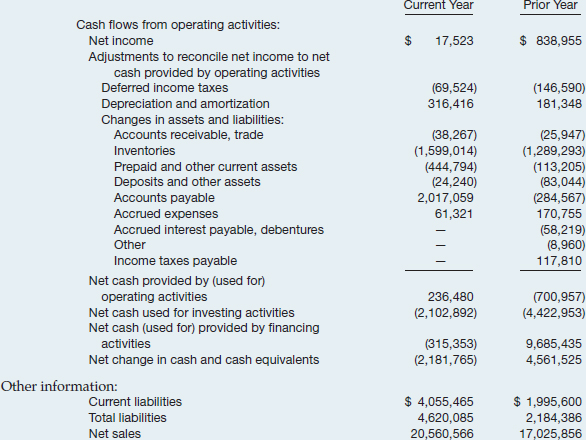
Instructions
- (a) Briefly describe any similarities or differences in Vermont's U.S. GAAP-based statement of cash flows compared to the requirements of IFRS.
- (b) Note that net income in the current year was only $17,523 compared to prior-year income of $838,955, but cash flows from operations was $236,480 in the current year and a negative $700,957 in the prior year. Explain the causes of this apparent paradox.
- (c) Evaluate Vermont Teddy Bear's liquidity, solvency, and profitability for the current year using cash flow-based ratios (as covered in Chapter 5).
Accounting, Analysis, and Principles
The income statement for the year ended December 31, 2015, for Laskowski Manufacturing Company contains the following condensed information.

Included in operating expenses is a €24,000 loss resulting from the sale of machinery for €270,000 cash. The company purchased machinery at a cost of €750,000.
Laskowski reports the following balances on its comparative statements of financial position at December 31.

Income tax expense of €353,000 represents the amount paid in 2015. Dividends declared and paid in 2015 totaled €200,000.
Accounting
Prepare the statement of cash flows using the indirect method.
Analysis
Laskowski has an aggressive growth plan, which will require significant investments in plant and equipment over the next several years. Preliminary plans call for an investment of over €500,000 in the next year. Compute Laskowski's free cash flow and use it to evaluate the investment plans with the use of only internally generated funds.
Principles
How does the statement of cash flows contribute to achieving the objective of financial reporting?
IFRS BRIDGE TO THE PROFESSION
Professional Research
As part of the year-end accounting process for your company, you are preparing the statement of cash flows according to IFRS. One of your team, a finance major, believes the statement should be prepared to report the change in working capital because analysts many times use working capital in ratio analysis. Your supervisor would like research conducted to verify the basis for preparing the statement of cash flows.
Instructions
Access the IFRS authoritative literature at the IASB website (http://eifrs.iasb.org/) (you may register for free eIFRS access at this site). When you have accessed the documents, you can use the search tool in your Internet browser to respond to the following questions. (Provide paragraph citations.)
- (a) What is the primary objective for the statement of cash flows? Is working capital the basis for meeting this objective?
- (b) What information is provided in a statement of cash flows?
- (c) List some of the typical cash inflows and outflows from operations.
Professional Simulation
The professional simulation for this chapter asks you to address questions related to the accounting for the statement of cash flows.
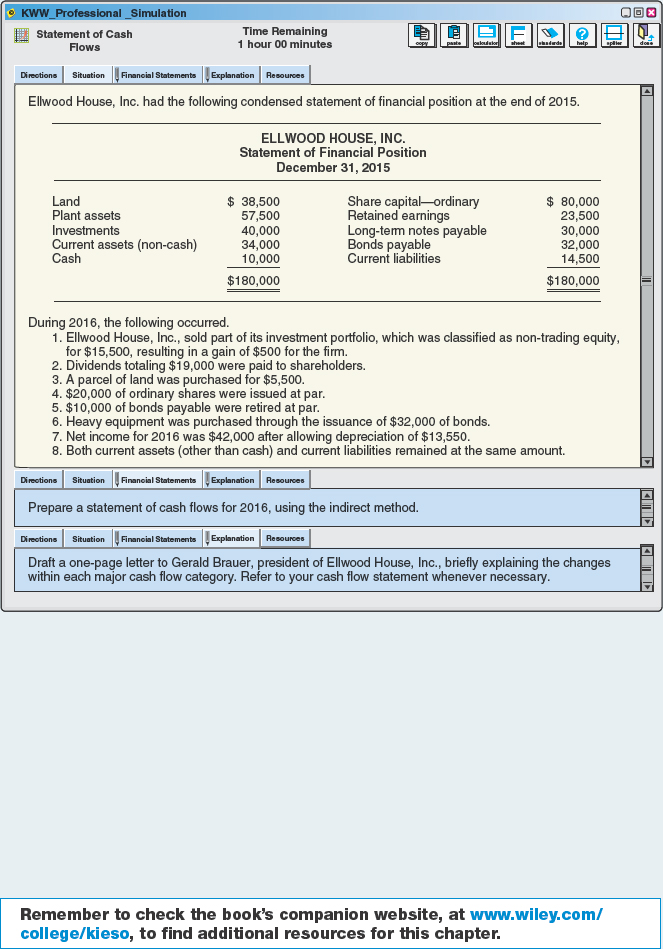
1IFRS Accounting Trends and Techniques—2012–2013 indicates that most companies surveyed report income taxes paid or received, interest received and paid, and dividends received as operating activities. However, most companies show dividends paid as a financing activity. These results are consistent with how this information is reported in Illustration 23-1.
2“Net cash flow from operating activities” is a generic phrase, replaced in the statement of cash flows with either “Net cash provided by operating activities” if operations increase cash, or “Net cash used by operating activities” if operations decrease cash.
3IFRS Accounting Trends and Techniques—2012–2013 reports that out of its 175 surveyed companies, 151 used the indirect method and 23 used the direct method. One company did not provide a statement of cash flows. In doing homework assignments, you should follow instructions for use of either the direct or indirect method.
4Other unrealized holding gains or losses, such as revaluations on property, plant, and equipment, or intangible assets, are also reported as part of other comprehensive income. As a result, net income is not adjusted in computing cash flows from operating activities for any type of unrealized holding gains or losses that are reported in other comprehensive income.
5In some countries, companies receive a tax deduction related to share-based compensation plans at the time employees exercise their options. The amount of the deduction is equal to the difference between the market price of the share and the exercise price at the date the employee purchases the shares, which in most cases is much larger than the total compensation expense recorded. When the tax deduction exceeds the total compensation recorded, this provides an additional cash inflow to the company. Under IFRS, this tax-related cash inflow should be reported in the financing section of the statement of cash flows. [5]
6Some non-cash investing and financing activities are part cash and part non-cash. Companies should report only the cash portion on the statement of cash flows. The non-cash component should be reported in a separate note.


